Part IV. Parallel Sections: Revenge of the Sith & A New Hope
In the dizzying opening shot of Revenge of the Sith, Lucas’s swansong to his galaxy far far away, the camera follows two Jedi starfighters, piloted by Anakin and Obi-Wan, as they zoom across the surface of a massively long Republic Assault ship and plummet over its side into the chaotic battle below.
As a militaristic rendition of the “Force Theme” plays on the soundtrack, Anakin and Obi-Wan dodge enemy fire and, at Lucas’s request, “fly in perfect harmony to express their friendship.” 1 It’s a breathtaking opener that recalls the visual storytelling prowess of the opening shot of A New Hope 28 years earlier (And at 76 seconds, it’s the longest shot of any Star Wars film).
But when it’s read in terms of the ring structure, another rich layer of complexity is revealed, along with the full extent of Lucas’s visual ingenuity. Because like Clones, Sith begins at the end of its corresponding episode. So, if you can believe it, the continuous shot that opens Sith is actually a wildly imaginative reinterpretation of the final scene in A New Hope, where, following the destruction of the Death Star, newfound friends Luke and Han march in unison up a very long aisle in a throne room medal ceremony—with a military-style “Force Theme” soaring in the background.
As the final film in Lucas’s Star Wars saga, Sith bridges the gap between the original trilogy and prequel trilogy. In terms of the ring composition, however, it’s the last piece of the puzzle.
First, much of Sith is based on Return of the Jedi, the third film in the original trilogy, just as Menace is based on the first film of the original trilogy and Clones is based on the second. (In fact, the title of Revenge of the Sith is a reference to an early working title of Jedi, Revenge of the Jedi).
But as part of the ABC C’B’A’ ring pattern, Sith corresponds instead to A New Hope. And, like the inverted relationship we saw between Clones and Empire, Sith and A New Hope correspond in a way that makes them appear as kind of mirror opposites. Let’s compare:
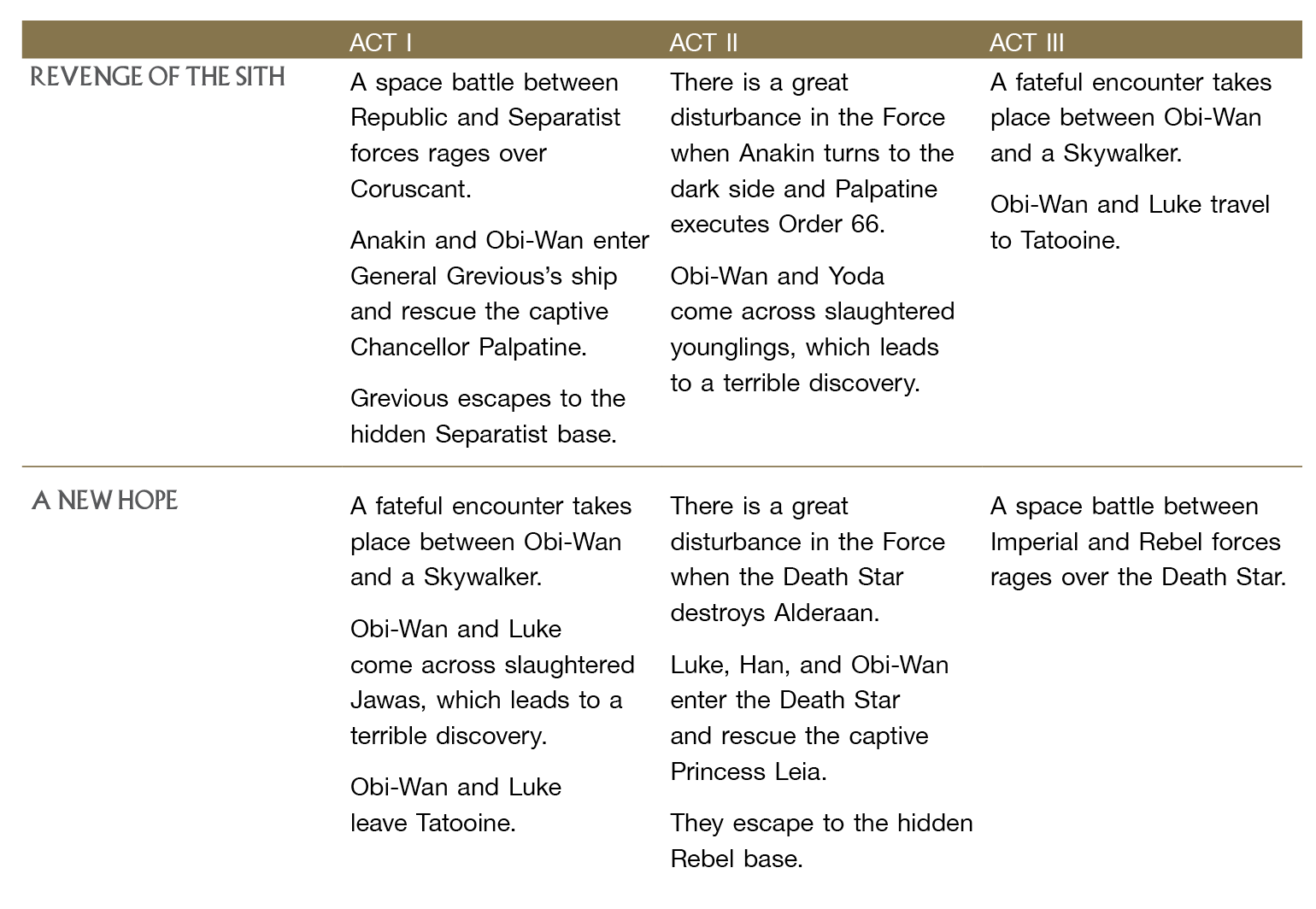
The similarities are once again quite striking, with plot elements from the beginning of A New Hope occurring at the end of Sith and plot elements from the end of A New Hope occurring at the beginning of Sith. Some of the elements have shifted between acts and been condensed, but the basic pattern remains the same.
Sith, then, continues the descent that began in Clones. And as we move towards the center of the ring (also the ring’s nadir) the imagery in Sith, like that in Clones, reflects Anakin’s slow, gradual fall to the dark side—moving from the upper regions of Coruscant’s atmosphere to the sinkhole planet of Utapau to finally, the hellish landscape of Mustafar.
The Beginning and the End
Like Clones and Empire, when Sith is read from this point of view, the connections between the start of the film and the end of A New Hope become increasingly visible.
After the reimagining of the throne room finale seen above, Sith plunges viewers into a hectic space battle followed by a daring rescue mission to free Chancellor Palpatine aboard Grievous’s flagship, the Invisible Hand. Even though it takes up the first 25 minutes or so of the film, it actually corresponds with the last half (roughly an hour) of A New Hope, echoing first the attack on the Death Star and then the rescue of Princess Leia. Let’s look at some examples:
The first line in the film, spoken by Anakin, is “Lock on to ‘em R2.” This subtly reflects the climactic moment in A New Hope when Luke, finally willing to “let go,” turns off his targeting computer and trusts in the Force before taking the final shot. As The Making of “Star Wars: Revenge of the Sith” notes, the line is intended to illustrate “how Anakin relies heavily on droids and computers to target the enemy (the opposite of his son, who will use the Force).” 2 (Admittedly, this was more overt in the film’s screenplay where Anakin says “Lock on to ‘em R2,” multiple times and at one point even flies his starfighter into a trench, recalling the famous Death Star “trench run” from A New Hope.)
From a shot inside Anakin’s cockpit, we see that “General Greivous’s ship is dead ahead,” recalling a similar shot in A New Hope from inside Vader’s TIE Fighter, when Vader has Luke directly in his sights.
In Sith, a clone pilot gives the command, “Set S-foils in attack position.” In A New Hope, after the X-Wing pilots report in, Red Leader orders, “Lock S-foils in attack position.” 3 (Also, Anakin and Obi-Wan’s ships are precursors to the Imperial TIE Fighter while the clones’ ships are precursors to the Rebel X-Wing, the two iconic vehicles used in the attack on the first Death Star.)
In Sith, Obi-Wan, whose ship is attacked by buzz droids, tells Anakin to “Get out of here. There’s nothing more you can do.” And during the attack on the Death Star, Luke tells the pilot Wedge, whose X-Wing is hit, to “Get clear. You can’t do any more good back there!”
Other lines of dialogue from A New Hope are twisted even more inconspicuously in Sith. For instance, “Switch all power to front deflector screens” becomes “Surge all power units, Artoo.” And “I can’t shake ‘em,” which is said twice, turns into “They’re all over me,” also said twice.
As Luke’s X-Wing streaks through the Death Star trench, R2D2 extends a repair arm to fix a “stabilizer that’s broken loose again.” And after a buzz droid crawls onto the wing of Anakin’s ship, R2 extends an arm to fend off the attack.
In A New Hope, Leia watches the attack on the Death Star from the Rebel command center, a darkly lit setting with green neon light emanating from various computer displays and glass walls. The same green neon light also appears prominently on the bridge of Grevious’s ship, which functions as the Separatist command center during the opening battle.
The opening space battle in Sith moves at breakneck speed, and only lasts about five minutes. Before we can even catch our breath, Obi–Wan exclaims “I’ve got a bad feeling about this” and his ship careens into the open hanger of Grevious’s ship with Anakin not far behind. At this point, six films into the series, it’s tempting to read the line as just a stale nod to tradition. But, like in the beginning of Menace, it’s actually being used to signal the ring structure. Because in A New Hope, Luke utters the well-known phrase for the first time when the Millennium Falcon is caught by the Death Star’s tractor beam—and pulled into an open hanger.
From this point, Sith begins to correspond to the scenes that take place when Luke and company are aboard the Death Star in A New Hope.
After a brief skirmish in the hangar in Sith, Obi-Wan orders R2 to plug into the ship’s computers and locate the Chancellor. After a brief skirmish in the Death Star command office in A New Hope, Obi-Wan orders R2 to plug into the battle station’s computer—at which point the little droid finds out where to deactivate the tractor beam and that Princess Leia is being held on board in the detention block. (In both films, the droids are left to wait behind while the rescue mission is undertaken.)
Before the Jedi head off to rescue Palpatine, Anakin looks around the hangar and says, “I sense Count Dooku,” echoing the moment in A New Hope when Vader stands in the Death Star hangar bay and says, “I sense something—a presence I’ve not felt since …”
Moments later in Sith, R2 finds himself hiding from two battle droids who’ve entered the hangar to search the Jedi starfighters. One of the droids overhears Obi-Wan’s voice over R2’s comlink and asks, “What that?” The second droid responds, “Get back to work. That nothing.”
This situation is meant to recall the scene in A New Hope where Obi-Wan powers down the Death Star’s tractor beam. To avoid detection from two stormtroopers, Obi-Wan uses the force to make them think they hear something down the hallway. “What was that?” the first trooper asks. “Oh, it’s nothing,” the second trooper replies.
Aboard the Invisible Hand, the Jedi use an elevator to reach the Chancellor. While deflecting laserfire with their lightsabers, they back into the elevator—unaware of the battle droids standing right behind them. Aboard the Death Star, Luke, Han, and Chewie use an elevator to reach the Princess. When the elevator arrives at the detention block, Luke and Han step forward to exit, but to their surprise the door actually opens up behind them.
Anakin and Luke both use a grappling hook to swing to safety over “bottomless pits.”
When the Invisible Hand takes heavy damage and goes into a nose dive, R2 slides and falls into a heap of broken battle droid parts. Moments later, R2’s periscope pops out of the junk pile and looks around—a very clever allusion to the trash compactor monster that pokes its periscope-like eye out of the sludge and looks around.
After Anakin and Obi-Wan rescue Palpatine, they’re captured and brought before General Grievous in a scene that corresponds to the detention block rescue scene in A New Hope.
“That wasn’t much of a rescue,” scoffs Grievous, in a line that clearly evokes “This is some rescue!”—Leia’s sarcastic complaint to her supposed “rescuers” after they become trapped. And Anakin tells General Grievous, “You’re shorter than I expected,” which echoes Leia’s famous line, “Aren’t you a little short for a stormtrooper?”
Both scenes erupt into fighting (with alarms sounding) after the “prisoners” create a distraction: In Sith, R2 extends all of his arms and shoots out electrical pulses while in A New Hope a handcuffed Chewbacca “gets loose.”
Both scenes also end on a similar note: Grievous escapes by breaking the ship’s window with his staff and getting sucked out into space whereas Luke and the gang escape when Leia blasts a hole through a grate into a garbage chute.
Lastly, Grievious’s escape to the secret Separatist base on the planet Utapau is a major plot point in Sith. The next part of the film involves the Republic finding Grievious and the Separatist base and launching a final attack. If this sounds familiar, it should, because it corresponds to the Millennium Falcon’s escape from the Death Star and subsequent retreat to the hidden Rebel base in A New Hope. Of course, the next part of that film involves the Empire at long last tracking down the location of the Rebels and launching a final attack.
The End and the Beginning
As you might expect at this point, if we continue to read Sith from the perspective of the ring composition, the end of the film references the beginning of A New Hope.
For example, transporting Yoda and Obi-Wan back to Coruscant, Senator Bail Organa receives a message from the Chancellor’s office requesting his presence for a special session of Congress. “It could be a trap,” Organa says to the Jedi. Obi-Wan doesn’t think so. “The Chancellor will not be able to control the thousands of star systems without keeping the Senate intact.” This line links directly to dialogue between Governor Tarkin and one of his generals during A New Hope’s Death Star conference room scene:
TARKIN: The Imperial Senate will no longer be of any concern to us. I’ve just received word that the Emperor has dissolved the council permanently. The last remnants of the Old Republic have been swept away.
TAGGE: That’s impossible! How will the Emperor maintain control without the bureaucracy?
TARKIN: The regional governors now have direct control over territories. Fear will keep the local systems in line. Fear of this battle station. 4
Also, you may not have noticed, but Yoda and Obi-Wan hitching a ride with Bail Organa to Coruscant actually corresponds to Han Solo transporting Luke and Obi-Wan off Tatooine.
More significantly, though, on their way to Anchorhead in A New Hope, Luke, Obi-Wan and the droids stumble across a burned-out sandcrawler surrounded by dead Jawas. Luke suspects that the Sandpeople did it. “They didn’t,” says Obi-Wan. “But we are meant to think they did. These tracks are side by side. Sandpeople always ride single file to hide their numbers … And these blast points, too accurate for Sandpeople. Only Imperial stormtroopers are so precise.” Confused, Luke asks, “But why would Imperial troops want to slaughter Jawas?” Luke glances at the droids when the answer dawns on him. He jumps in his landspeeder and races home only to the find the smoking ruins of the moisture farm and the charred skeletons of his aunt and uncle. With nothing left to hold him back, Luke resolves to join Obi-Wan and become a Jedi.
After Yoda and Obi-Wan survive “Order 66” in Revenge of the Sith, they infiltrate the Jedi temple to reprogram a message and warn any remaining Jedi to stay away instead of returning. And in a scene clearly meant to evoke the one at the attacked sandcrawler, Yoda and Obi-Wan walk through the temple ruins and come upon the dead bodies of Jedi children.
Both scenes contain bodies strewn across the ground with smoke still hanging in the air. Also, notice the reverse diagonal compositions in the shots above. A brief exchange of dialogue further strengthens the connection between the two scenes:
OBI-WAN: Not even the younglings survived.
YODA: Killed not by clones, this Padawan. By a lightsaber, he was.
OBI-WAN: Who? Who could have done this? 5
Similar to Luke’s question about why Imperial troops would want to slaughter Jawas, Obi-Wan’s question will lead to a terrible discovery. A review of surveillance recordings reveals that it was Anakin who killed the young Jedi students. Anakin Skywalker, like Luke’s Uncle Owen and Aunt Beru, is no more. “Twisted by the dark side, young Skywalker has become,” Yoda tells Obi-Wan. “The boy you trained, gone he is . . . consumed by Darth Vader.” Although reluctant, Obi-Wan agrees to face his former apprentice.
When Padme learns about Anakin from Obi-Wan, she flies to the lava-soaked planet of Mustafar to confront her husband, who’s traveled there because the Chancellor gave him a “very important mission.” She’s accompanied by C3PO, who pilots the skiff.
Eagle-eyed viewers may recall that C3PO is driving Luke’s landspeeder when the two set out across the desert to search for R2 in A New Hope. And similar to Anakin, R2 is on a “secret mission” (to deliver Leia’s message to Obi-Wan).
On Mustafar, Anakin uses the force to choke Padme nearly to death until Obi-Wan stops him, yelling “Let her go!” Likewise, in A New Hope Vader force chokes Admiral Motti to the brink of death until Tarkin commands, “Enough of this! Vader, release him.”
Early in A New Hope, Vader physically lifts the captain of the Rebel Blockade Runner off the ground (with his left hand) and chokes him to death. During the duel on Mustafar, Anakin grabs Obi-Wan by the throat (with his right hand) and forces him down on a table.
Both the last act of Sith and the first act of A New Hope center around the destiny-defining encounter between a Skywalker and Obi-Wan Kenobi. But Sith puts a twist on this “Supernatural Aid/Meeting with the Mentor” stage of Joseph Campbell’s “Monomyth,” or Hero’s Journey.
When Luke is attacked by Sandpeople on Tatooine, Obi-Wan comes to his rescue. Similarly, when Anakin is left for dead on Mustafar, Palpatine—Anakin’s new, dark mentor—comes to his rescue and saves his life. Palpatine, like Obi-Wan, kneels down and places his hand on Skywalker’s forehead.
Shortly thereafter, the newly christened Darth Vader—encased in the iconic black armored life-support suit—rises from an operating table in a dark, smoke-filled scene straight out of Universal’s Frankenstein films. This “first appearance” of Darth Vader at the conclusion of the prequels nicely reflects his dramatic entrance into the smoky, brightly lit white corridor of the Rebel Blockade Runner at the beginning of A New Hope.
In addition, the first time Vader speaks in both films, he asks a series of three questions. In A New Hope:
Vader squeezes the neck of the Rebel Officer, who struggles in vain.
VADER: Where are those transmissions you intercepted?
Vader lifts the Rebel off his feet by his throat.
VADER: What have you done with those plans?
REBEL OFFICER: We intercepted no transmissions. Aaah … This is a consular ship. We’re on a diplomatic mission.
VADER: If this is a consular ship … where is the Ambassador? 6
In Sith:
DARTH SIDIOUS: Lord Vader, can you hear me?
VADER: Yes, My Master.
DARTH VADER looks around the room.
VADER: (continuing) Where is Padme? Is she safe, is she all right? 7
The first line spoken in A New Hope is “Did you hear that?” by C3PO, in a quick exchange with R2 on the fleeing blockade runner at the start of the film. Given the circular structure of the saga, it’s only appropriate then that C3PO utters the last line in Sith, “Oh no!”—in a short conversation with R2 aboard a space cruiser that looks nearly identical to the Rebel ship.
As you can see, the relationship between Sith and A New Hope is the same as the one between Clones and Empire: elements towards the start of Sith correspond to those at the end of A New Hope, and elements at the end of Sith correspond to those at the start of A New Hope. Importantly, this pattern continues the sense of descent towards the center of the ring.
Beginnings, Middles, and Ends
Just as in the previous pairs, progressing through Sith uncovers corresponding elements to A New Hope that run parallel, with elements once again being imaginatively reinterpreted.
For instance, earlier we saw that the opening of Sith was an inventive reimagining of A New Hope’s final scene. But it’s also a subtle inversion of the opening of A New Hope. After the camera pans down in A New Hope, a seemingly endless Imperial Star Destroyer flies over a stationary camera.
The pan down in Sith, instead, reveals that the camera is high above a Republic Star Destroyer, looking straight down at it. The camera then moves, tracking the Jedi starfighters as they fly overtop the equally endless capital ship.
General Grievous, a cyborg with breathing difficulty that foreshadows Anakin’s transformation into Darth Vader, first appears on screen entering the bridge of his ship—through a door, followed by two bodyguards. This echoes the first appearance of Darth Vader, striding through the doorway of the blockade runner, flanked by two stormtroopers.
Like A New Hope, the first part of Sith focuses primarily on two characters. In the first part of Episode IV, the story is told mainly from the point of view of C3PO and R2D2 (a device used by Akira Kurosawa in The Hidden Fortress with two bickering peasants). The two lowly droids flee the Rebel Blockade Runner in an escape pod that crashes down in the dunes of the Tatooine desert. In the first part of the Episode III, the story focuses primarily on Anakin and Obi-Wan, who are forced to crash-land the Invisible Hand after Grievious flees the ship in an escape pod and jettisons all the remaining pods.
When cleaning R2, Luke accidentally stumbles across a hologram of Princess Leia pleading for help, a vital message that draws Luke into a quest to rescue her. In Sith, Lucas reinvents this crucial plot point, rather brilliantly, as Anakin’s nightmare about Padme dying in childbirth.
Much like Leia’s holographic message, the vision of Padme will draw Anakin into a life-saving quest. And if you listen carefully during Anakin’s first nightmare, Padme cries, “Anakin, help me,” which, of course, echoes Leia’s “Help me, Obi-Wan Kenobi. You’re my only hope.” In addition, the holographic message is played twice in A New Hope, the second time with Obi-Wan in his hut. In Sith, we witness two of Anakin’s nightmares, with Obi-Wan appearing in the second one.
The scene with Luke and Obi-Wan inside the Jedi Master’s hut takes place around the 35-minute mark. When Luke asks how his father died, Obi-Wan tells him: “A young Jedi named Darth Vader, who was a pupil of mine until he turned to evil, helped the Empire hunt down and destroy the Jedi Knights. He betrayed and murdered your father. Now the Jedi are all but extinct. Vader was seduced by the dark side of the Force.” 8
At the same time in Sith, Anakin and Yoda sit inside “Yoda’s Quarters” in the Jedi Temple and discuss Anakin’s premonitions. The dialogue not only parallels but also expands on Obi-Wan’s answer to Luke—enhancing our understanding of Anakin’s eventual “seduction” by the dark side and making explicit the emotional issues at the heart of the saga:
YODA: Careful you must be when sensing the future, Anakin. The fear of loss is a path to the dark side.
ANAKIN: I won’t let these visions come true, Master Yoda.
YODA: Death is a natural part of life. Rejoice for those around you who transform into the Force. Mourn them, do not. Miss them, do not. Attachment leads to jealousy. The shadow of greed, that is.
ANAKIN: What must I do, Master Yoda?
YODA: Train yourself to let go of everything you fear to lose. 9
Greed, of course, is the main driving force behind Anakin’s turn to the dark side. He becomes Darth Vader “because he gets attached to things,” says Lucas. “He can’t let go of his mother … his girlfriend … things. It makes you greedy. And when you’re greedy, you are on the path to the dark side because you fear that you’re going to lose things. You fear you’re not going to have the power you need.” 10
After Obi-Wan watches Leia’s message in A New Hope, he tells Luke that he must learn the ways of the Force and come with him to the planet Alderaan. When Luke refuses, Obi-Wan says, “I need your help, Luke. She needs your help. I’m getting too old for this sort of thing.”
Shortly after the scene between Anakin and Yoda in Sith, Palpatine—a father figure to Anakin just as Obi-Wan is a father figure to Luke—also asks for Anakin’s assistance:
PALPATINE: I need your help, son.
ANAKIN: What do you mean?
PALPATINE: I’m depending on you.
ANAKIN: For what? I don’t understand.
PALPATINE: To be the eyes, ears, and voice of the Republic. Anakin, I’m appointing you to be my personal representative on the Jedi Council. 11
In the Mos Eisley spaceport, Luke and Obi-Wan walk to the docking bay to leave for Alderaan when a long-snouted alien spots them and quietly alerts Imperial Stormtroopers to the location of the heroes (Rebels). On the planet Utapau, Obi-Wan arrives looking for Grievous when a tall, lanky alien secretly gives him the location of the villains (Separatists).
Minutes later, both films cut to an establishing shot of a spherical-shaped base, then to a villainous leader, standing with his back to the camera and his hand(s) behind his back.
In the ensuing scene on the Death Star, Tarkin threatens to destroy Alderaan unless Leia reveals the location of the Rebels’ hidden base. A defiant Leia says, “The more you tighten your grip, Tarkin, the more star systems will slip through your fingers.” In the scene on Utapau, Grievous warns the Separatist leaders that the Republic will soon discover their secret base so they must go to Mustafar where they’ll be safe. Two lines of dialogue echo Leia’s line:
NUTE GUNRAY: Safe? Chancellor Palpatine managed to escape your grip, General, without Count Dooku. I have doubts about your ability to keep us safe.
GENERAL GRIEVOUS: Be thankful, Viceroy, you have not found yourself in my grip. 12
Aboard the Millennium Falcon, Luke trains with his lightsaber and receives his first “mind-expanding” lesson in the power of the Force. He wears a helmet that covers his eyes (which can “deceive you,” remarks Obi-Wan) and successfully deflects lasers from a hovering remote. Obi-Wan congratulates him: “You’ve taken your first step into a larger world.”
When Palpatine reveals his identity as the mysterious Darth Sidious to Anakin (who’s been blind to the truth), he advises Skywalker to broaden his horizons, so to speak: “Anakin, if one is to understand the great mystery, one must study all its aspects, not just the dogmatic, narrow view of the Jedi. If you wish to become a complete and wise leader, you must embrace a larger view of the Force.” 13
On the Death Star, Luke comes up with the idea to pose as Stormtroopers escorting a prisoner to the detention block. Luke takes metal binders and tries to place Chewbacca “under arrest” but the wookiee objects and growls loudly. Occurring simultaneously in Sith, Mace Windu and three other Jedi attempt to arrest Palpatine. The Chancellor, like Chewbacca, also objects and screams (as he spins through the air with a lightsaber.) Both scenes even contain the same number of characters: five.
Halfway through A New Hope, the planet Alderaan is destroyed. Inside the Millenium Falcon, Obi-Wan suddenly appears distraught. He places his hand over his chest and sits down. “I felt a great disturbance in the Force,” he tells Luke. “As if millions of voices suddenly cried out in terror, and were suddenly silenced.” Then, he puts his hand on his forehead, as if in pain.
Halfway through Revenge of the Sith, Anakin turns to the dark side. He kneels before his new master Darth Sidious and is anointed Darth Vader. Then, for a brief moment, the scene cuts away to Yoda, who is visibly shaken. Shortly thereafter, during the “Order 66” montage that highlights the extermination of the Jedi, Yoda echoes the exact gestures of Obi-Wan—connecting Anakin’s turn and the murder of the Jedi to the mass murder on Alderaan.
The walls of the trash compactor begin to close in on Luke, Leia, Han, and Chewie around 80 minutes into A New Hope. At the same time in Sith, the walls close in on the Jedi when Order 66 is commenced. (It’s probably no accident either that we see four Jedi die onscreen in Sith, the same number of characters we almost see die in the trash compactor in A New Hope.)
Also of note is that both films include a character going under water at this point. Luke gets pulled under the murky waters of the trash compactor by the one-eyed monster and Obi-Wan falls hundreds of feet into a sinkhole filled with clear blue-green water.
Obi-Wan sneaks around the Death Star to disable the tractor beam around 85 minutes into A New Hope. And sure enough, 85 minutes into Sith, we see Obi-Wan sneaking around Utapau, trying to reach a starfighter on a secret landing platform. Notice how Lucas creates a subtle visual link between the two scenes. In both of the shots below, Obi-Wan tries to avoid detection from “troopers.” Both shots appear “flattened,” with an object essentially splitting the frame into two at an angle—with characters on both sides. In Sith, Obi-Wan (on the right side of the frame) hides from clonetroopers (left side). In A New Hope, it’s reversed.
Finally, in A New Hope the Empire allows Princess Leia and her friends to escape the Death Star after planting a homing beacon on the Millennium Falcon, thus revealing the location of the hidden Rebel base. The final battle ensues shortly thereafter.
Towards the end of Sith, Obi-Wan visits Padme and reveals to her the truth about Anakin and asks about his whereabouts. She lies and says she doesn’t know. Obi-Wan leaves, knowing that Padme will immediately go to Anakin. And like the tracking device onboard the Falcon, Obi-Wan secretly stows away on her ship—and confronts his former pupil in the film’s final battle.
Notes:
- J. W. Rinzler, The Making of “Star Wars: Revenge of the Sith,” (New York: Del Rey Books, 2005), 160. ↩
- Ibid., 167. ↩
- While the line is also spoken in Jedi during the attack on the second Death Star, the reverse angles between shots suggest a deliberate link between Sith and A New Hope. ↩
- George Lucas, Star Wars, Original Movie Script, (Monterey Park, CA.: O.S.P. Publishing, Inc., 1994), 45. ↩
- George Lucas, Star Wars: Episode III – Revenge of the Sith, Screenplay, (The Internet Movie Script Database), http://www.imsdb.com/scripts/Star-Wars-Revenge-of-the-Sith.html. ↩
- Lucas, Star Wars, 5. ↩
- Lucas, Sith. ↩
- Lucas, Star Wars, 42. ↩
- Lucas, Sith. ↩
- Richard Corliss and Jess Cagle, “Dark Victory,” Time, April 29, 2002, http://content.time.com/time/magazine/article/0,9171,1002323,00.html. ↩
- Lucas, Sith. ↩
- Ibid. ↩
- Ibid. ↩

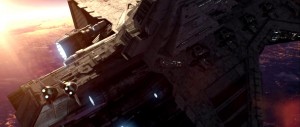
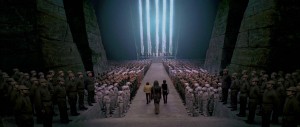
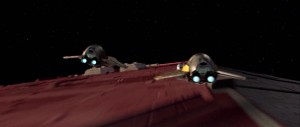
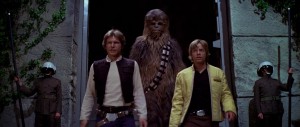
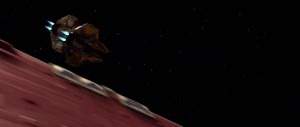
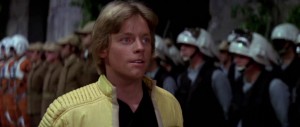
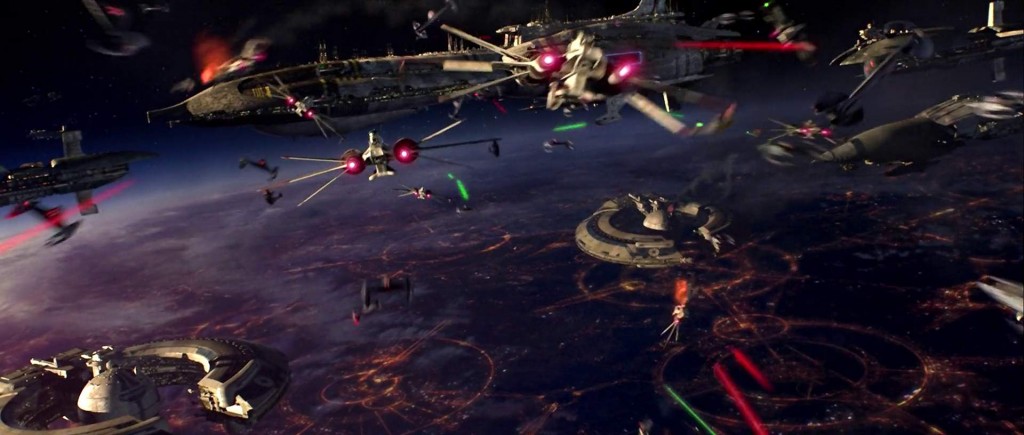
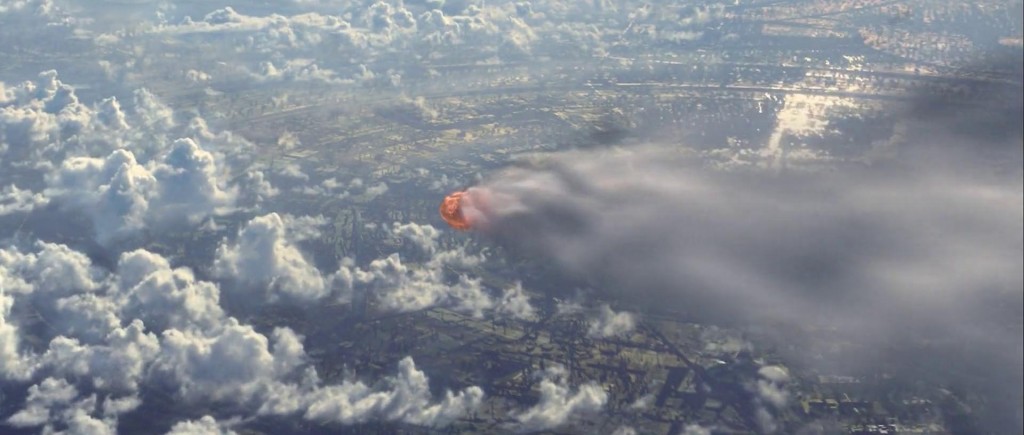
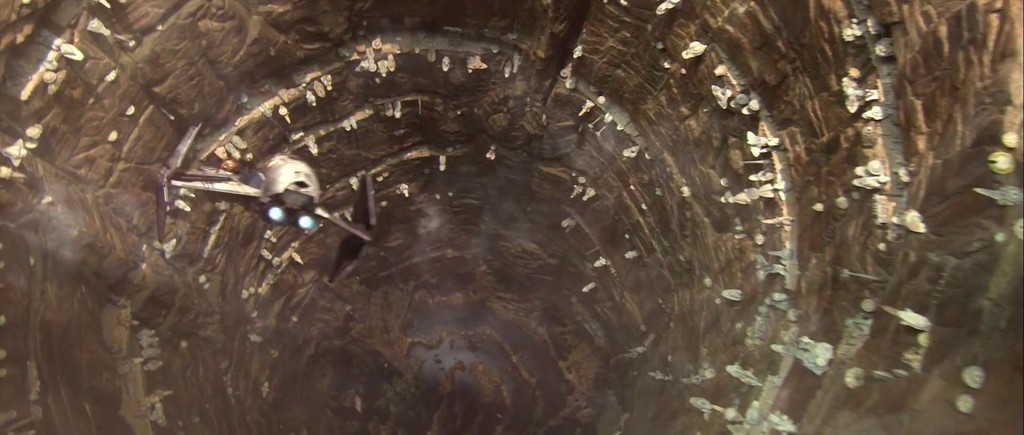
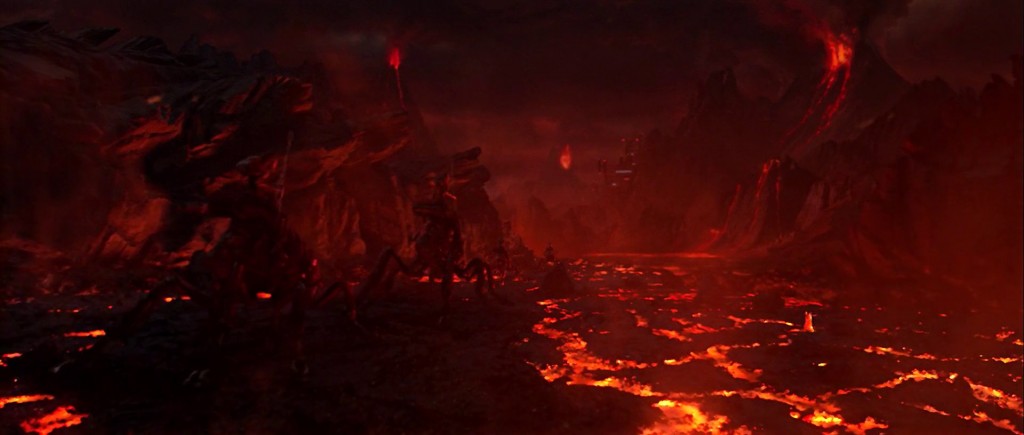
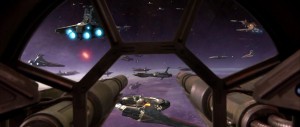
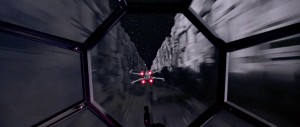
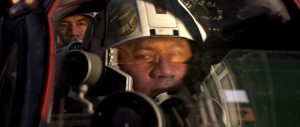
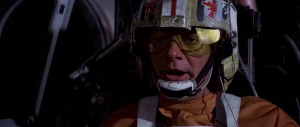
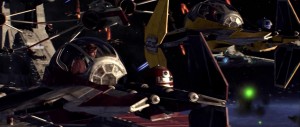
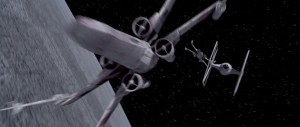
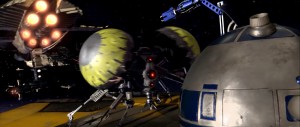
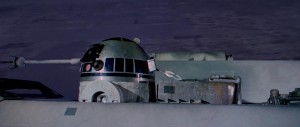
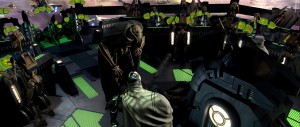
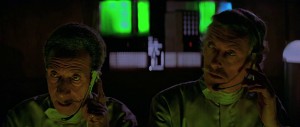
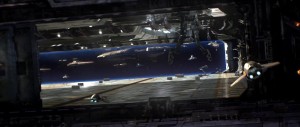
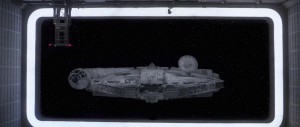
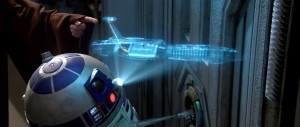
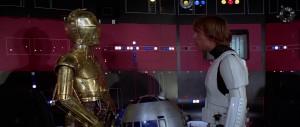
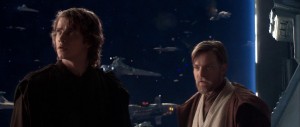
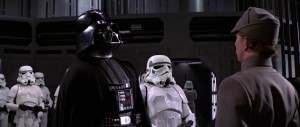
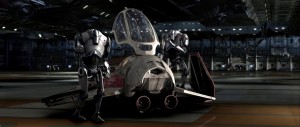
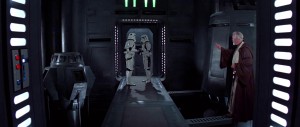
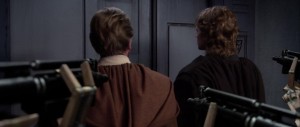
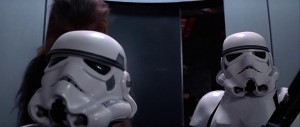
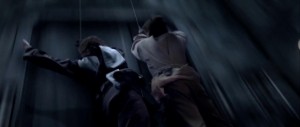
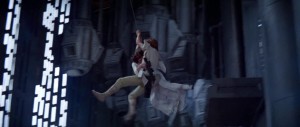
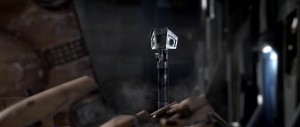

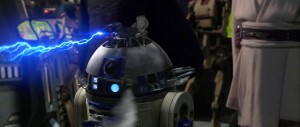
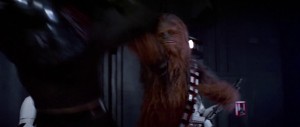
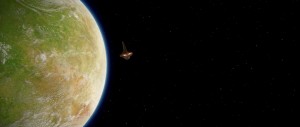
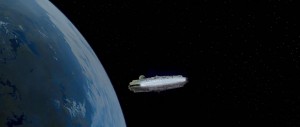
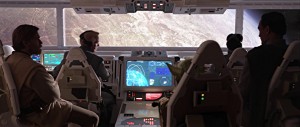
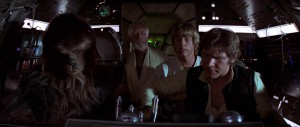
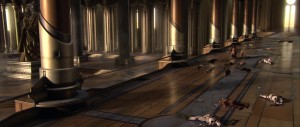
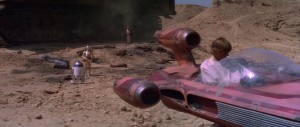
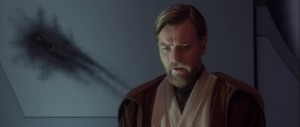
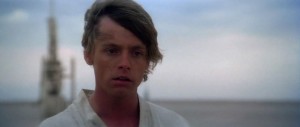
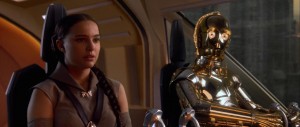
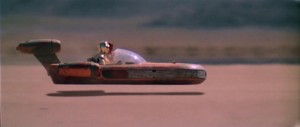
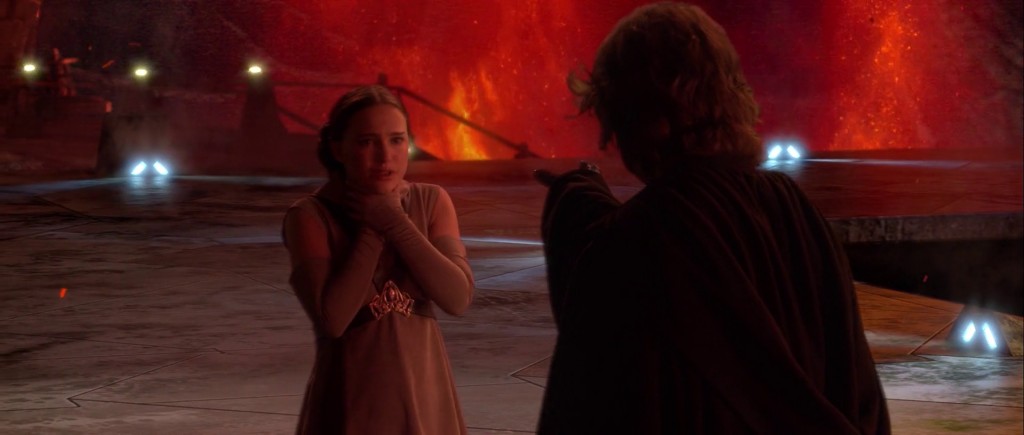
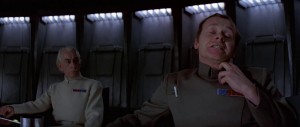
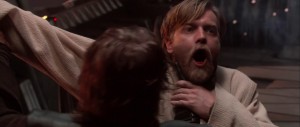
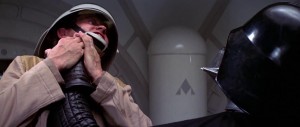
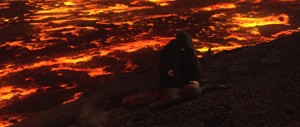
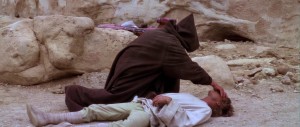
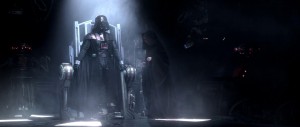
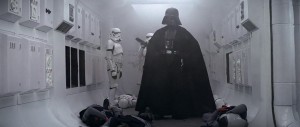
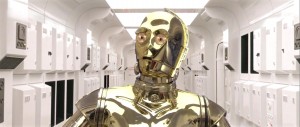
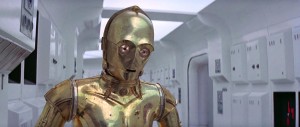
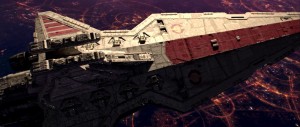
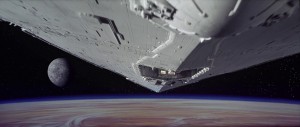
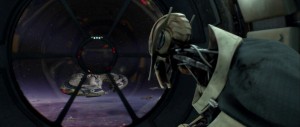
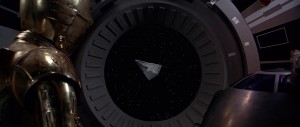
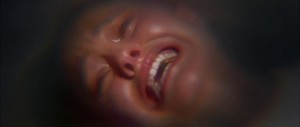
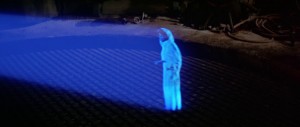
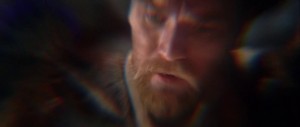
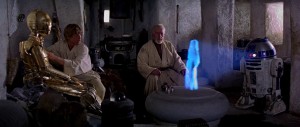
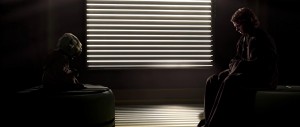
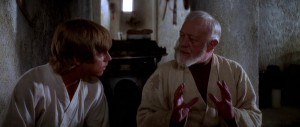
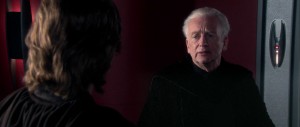
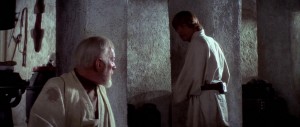
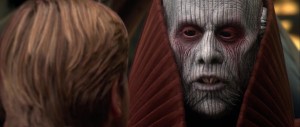
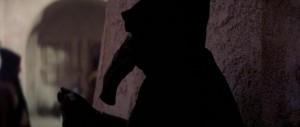
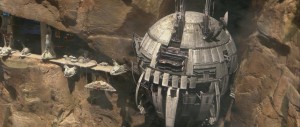

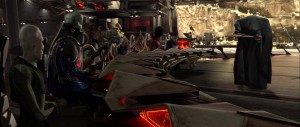
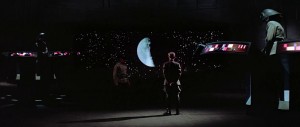
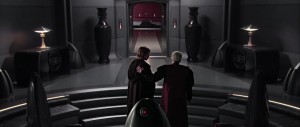
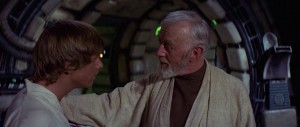
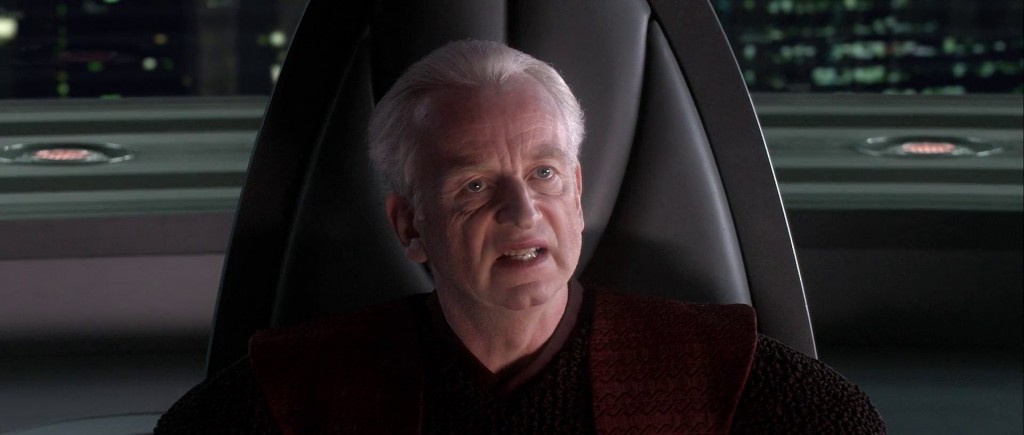
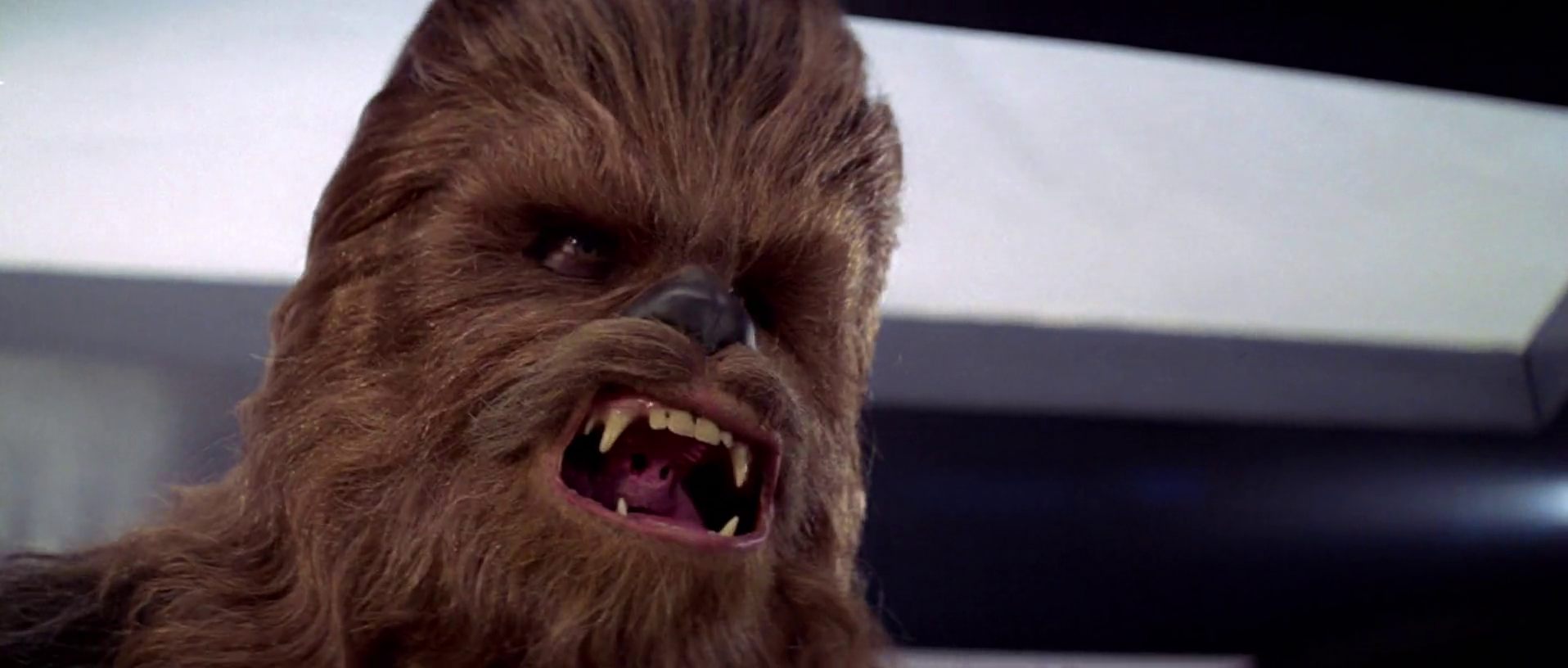
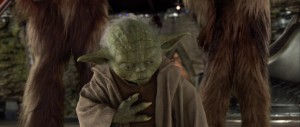
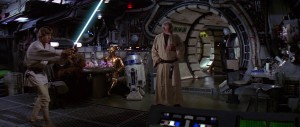
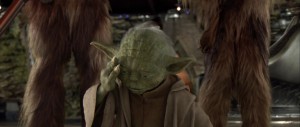
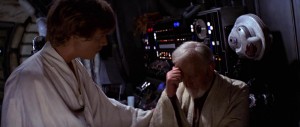
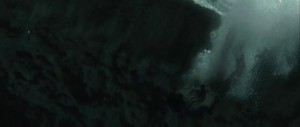
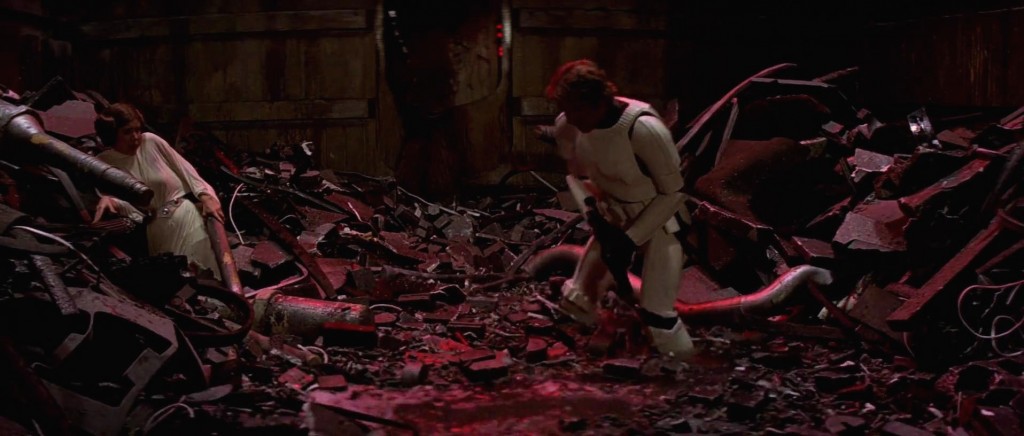
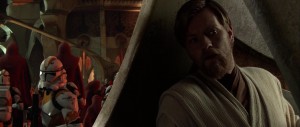
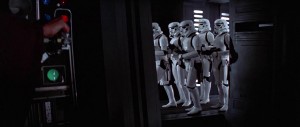
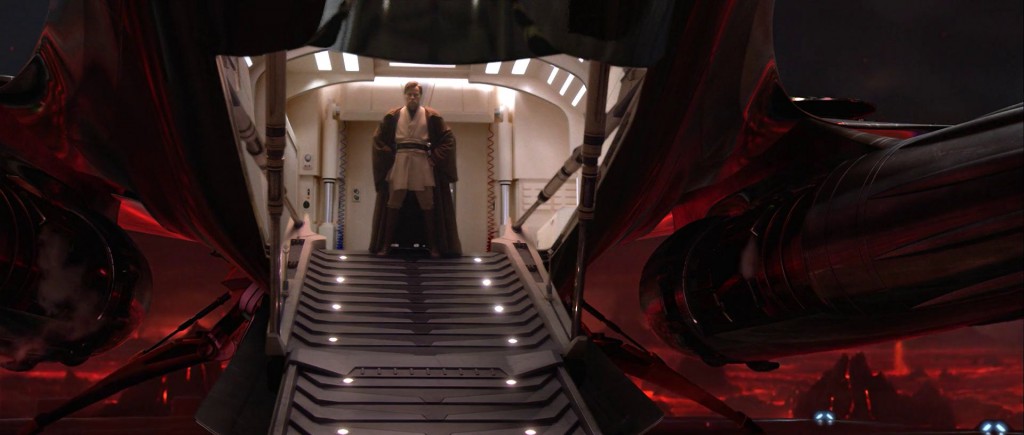
I have never been a fan of the prequels but this interconnectivity has given me something to think about. Pretty compelling evidence Mike! I think you are certainly on to something with this. Viewed through this lens the narrative between the six films becomes far more impressive. This is a must read for the SW community!
Though this essay may look daunting at first it really is a fresh and illuminating take on the inter-connectivity of all 6 Star Wars movies. An in depth analysis but easy to read article sheds new light on how big of universe Lucas really created. Fascinating read Mike!
This essay is amazing! It is one of the smartest and most in-depth pieces I’ve seen on Star Wars. I can’t imagine how much time and effort went into creating this. I love the Prequel Trilogy and this made me appreciate them even more.
That was one of the most insightful essays I’ve ever read. I found myself literally gasping out loud several times while reading this. I too have been fascinated with the connection between Daoism and Star Wars, but have never known about the Ring narrative device. There’s no question that this essay gave me a completely new appreciation for the prequels and Star Wars in general. I also think there’s something to be said for Star Wars serving as a modern vessel for concepts such as the “middle path”, Jung’s “collective shadow”, and “wholeness” of self. The message of Star Wars is universal to human culture, and your essay did a fantastic job of exploring that in a serious way, and supporting it with excellent research. So all I can say now, is:
Thank you.
This is an amazing piece of research and critical thinking! Mike does such an amazing job of not only peeling away the layers of the onion, but finding layers of the onion we never knew were there. Brilliant and inspired.
This was absolutely incredible! I have always loved the prequels and this has made me love them even more. I appreciate all the work that went into this….. obviously a ton! I have shared it on Facebook as well. Thanks for giving me such good insight into the Star Wars saga!
What’s Going down i’m new to this, I stumbled upon this I have
found It positively helpful and it has aided me out loads.
I’m hoping to give a contribution & help other customers like its aided
me. Great job.
This is a well researched, scholarly, and critical analysis of Star Wars that demands your attention in a way as compelling as the writings of Campbell himself. Not since The Hero with a Thousand Faces have I read a piece that is as justifiably complex yet accessible to every fan of narrative. I hope that Lucas himself one day addresses the analysis presented here–and we find that Klimo has unlocked a new secret of Star Wars storytelling.
A well written article, but it’s like trying to see how similar a turd is to a bar of gold. If the prequels were actually any good, this would make sense. But I stand with Red Letter Media on this.
I would love to explore this further, but it would mean I would have to watch those awful prequels again. Any other ring shaped movies out there?
An interesting read with some great ideas, though I wonder how this will eventually pan out because there will be 9 movies.
Plus, I’ve also read somewhere (wish I knew where) that the animated series “Clone Wars” covers more about Anakin to explain more of his descent into darkness.
Also, are there references out there that say how much of the prequels was fleshed out before the original 3?
I am sorry, but this is a very long article that kind of explains what I already knew.
I could see the parallels between Return of the Jedi and the Phantom Menace from first viewing.
Yet this doesn’t excuse well…. anything.
Nothing about this “Ring Storytelling” requires JarJar be an offensive Jamacan/Black Slave stereotype and the enemies be offensive Chinese stereotypes.
Nothing about it excuses start Anakin off as 8 instead of 17 and thus have a lot of his heroics, including his winning of the climatic battle, be a complete accident.
Nothing about it excuses the Droids in the Droid army being so unreasonably incompetent at everything.
Nothing about it excuses the hokey dialogue in even the scenes meant to be serious and bad jokes.
It doesn’t excuse the introduction of “mitichlorians” in such a way that many took it to mean they were the root cause of Jedi powers and clearing that up only in interviews and supplementary guidebooks.
It doesn’t excuse Qui-Gong Jinn’s choice to do everything he does in the most ineffective, dumb and short-sighted of ways and only survive as long as he did on pure luck, enemy incompetence and plot contrivance.
Literally 80% of the issues regarding the Phantom Menace and the rest of the prequel trilogy could have been fixed without at all detracting from this ring storytelling.
1. “Plus, I’ve also read somewhere (wish I knew where) that the animated series “Clone Wars” covers more about Anakin to explain more of his descent into darkness” – It doesn´t since it shows us just a very short era between episodes II and III. Episodes I, II and III show us everything we need to understand his fall.
2. „Also, are there references out there that say how much of the prequels was fleshed out before the original 3?“ – Who gives a shit about how much of the prequels was fleshed out before the original 3? Because i don´t. Eps I, II, III are already made, so it doesn´t matter.
3. ” Nothing about this “Ring Storytelling” requires JarJar be an offensive Jamacan/Black Slave stereotype and the enemies be offensive Chinese stereotypes.” – They aren´t. The actor portraying Jar Jars is black but that was just a coincidence. He portrayed him because of his great physical acting and voice acting, not because he´s black.
4. „Nothing about it excuses start Anakin off as 8 instead of 17 and thus have a lot of his heroics, including his winning of the climatic battle, be a complete accident. „ – It was actually a combination of good luck, Anakin´s skills as a pilot and his Force powers and the shield of the droid control ship´s hanger being lowered to allow several droid fighters to fly out into the battle.
5. „Nothing about it excuses the Droids in the Droid army being so unreasonably incompetent at everything.“ – They´re not that incopetent considering the fact that it took just two droidekas to fight Qui-Gon and Obi-Wan off and the fact that the battle between Droid army and Gungan army ends by the Droid army defeating the Gungan army.
6.“ Nothing about it excuses the hokey dialogue in even the scenes meant to be serious and bad jokes.“ – That´s your personal feeling. It has nothing to do with logical arguments which is what Klimo´s essay is all about.
7. „It doesn’t excuse the introduction of “mitichlorians” in such a way that many took it to mean they were the root cause of Jedi powers and clearing that up only in interviews and supplementary guidebooks.“ They are called midi-chlorians . By the way the film itself makes it perfectly clear what they are and what their funcion and purpose is. I know this because I didn´t have any problem understand that immediatly. I didn´t need tho read or heard the interviews and I didn´t have tho read any suplementary quidebooks. That´s probably because I actually paid attention tho the story.
8. „It doesn’t excuse Qui-Gong Jinn’s choice to do everything he does in the most ineffective, dumb and short-sighted of ways and only survive as long as he did on pure luck, enemy incompetence and plot contrivance.“ – Qui-Gon choices are questioned numerous times during the film by other characters like Obi-Wan, the Jedi Council, Padme and Captain Panaka. That means that even audience itself is supposed to question his actions. Also, characters making questionable, misquided or even bad choices is not necessarly the same thing as bad storytelling. Also the talk about plot contrivances may be just a personal feeling as well. Especialy when you don´t give any examples of them to support your conslusions. It can be also an example of certain viewer being lazy, incopetent and not paying enough attention tho the plot and the story as in the case of that Red Letter Media moron, IMHO.
9. „Literally 80% of the issues regarding the Phantom Menace and the rest of the prequel trilogy could have been fixed without at all detracting from this ring storytelling.“ – Why don´t give us any examples? By the way I don´t believe that there is always just one right way how to tell a story.
Just amazing. Amazing.
I made my thesis from college (Communication sciences) about it. It was a mythological, narrative and cultural analysis of the saga, using the Campbell theory and studding the way to construct a story for cinema.
I totally agree with this article. it´s a very interesting and deep analysis of the saga. provides solid arguments that prove the prequel trilogy is as good or even better in some ways than the original trilogy, and of course, destroy all the critics made for people that only throw sheet to the prequels because they think is cool and of course, because they don´t have any idea of how to properly analyze a movie.
I am watching all the Star Wars films again and again, through the eyes of my 4 year old boy, he loves them, and I am finding a whole new appreciation for he prequels , as well as the original trilogy. These articles reinforce the immense creative nature of the Star Wars universe, and the patience that GL must of had between New Hope and Episodes I, II and III.
The critics can continue to live in their poor little reality.
I will continue to enjoy the stories for many years to come, especially now that our 2nd son, Anakin (yes that’s right, we named him Anakin), is now just getting old enough to start experiencing the Star Wars magic.
Excellent work! Congratulations on the discovery of a very complex chiasmus in Lucas’ epic and modern-classic. Wrote my PhD on the chiasmic structure of a much more ancient classic, a 1st century Buddhist scripture called the Prajñāpāramitā. I also made the connection with Campbell’s “hero meta-myth”, thanks to an earlier scholar. And apparently Lucas considered Campbell to be his Yoda (or something to that effect).
Chiasmus in the Early Prajñāpāramitā: Literary Parallelism Connecting Criticism & Hermeneutics in an Early Mahāyāna Sūtra
http://prajnacara.blogspot.hk/2013/03/chiasmus-in-early-prajnaparamita.html
” But symbolically, like Anakin and Luke, Mace—representing the Jedi and the greater Republic—is the one who’s “lost his head.” ”
There is one further paralel – both Mace and Luke realize exactly what has happened, what they have become and what implications it has. Take a look at how Mace pauses and looks at Jango’s severed head, just as Luke pauses and looks at illusion’s severed head.
If I were so inclined, I would write a lengthy article on how Star Wars ring theory and Red Letter Media create some yin yang, ring interconnected thing that balance out each other. But, who has got the time? I’ll just say I give both the same conclusion: 10% truth and interesting points; 90% ranges from nit picky and unlikely to completely overblown and outlandish. To summarize the 10% from each that I think are most likely true: the prequels use some interesting story telling devices and allusions that connect to the overarching story, but they fail miserably when it comes to creating characters I care about. But, hey, it is all for fun. I was actually watching episode 1 earlier today.
Excellent work. The Saga is a Magnus Opus, in the true sense. No modern work can come close to it. I suspect Lucas worked for years (upon years) on it, perfecting the whole.
About the Prequels, I believe all the negativity around it can actually be explained. Let me try..
For me the prequels have always been a ‘confrontational descent’. As described, everything goes wrong, all the time. Even when a triumph is achieved, there is always a negative side effect. You cannot lean back and watch the ‘goodness’ unfold (good simply triumphing over evil). The prequels are negative, catastrophic films. And, so, they are actually by nature BAD films!
I remember when I was a student, in 2002, I had a part time job at a factory. Attack of the Clones was in theater at that time. I remember during the brake one of my co-workers complained about the movie. He went to see it the night before. He thought it was crazy BAD, like worthless. I remember he said the old ones were GOOD, so much better, and much more fun..
This guy wanted to have a fun, ‘uplifting’ experience. Happiness. An experience of the ascent.
Like the story on this blog, I perceive the Original Triology as the ‘inspiring ascent’. True escapism from the mundane. The good guys win. All things bad are defeated. These are GOOD, inspiring movies.
A lot of people, like my co-worker, just want to watch a ‘good’ movie. A fun movie, with a happy ending (ascent).
There is a lot more to this. For instance. A lot of people conceive a good dark (BAD) movie as fun (GOOD). Then why not the Prequels you might ask? Because they are confrontational, i’d say. The prequels actually show why things go wrong, how evil comes about, and why we, ourselves, are responsible. RESPONSIBLE. They play into our (sub)consciousness. They never indulge in the badness. They actually make us feed confused, and many even BAD!
….
Why do a lot of people love the prequels? Well, there is a lot to love, right? Are we better than the factory worker, because the people who like the prequels are interested in more than a mere need for fun and understand deeper motives, and maybe are open to them? ARE they better than the factory worker who thinks the prequels are plain bad and just needs some happy-fix?
The question of judgement doesn’t exist in this, I would say. No one is better or worse. Some people love them, some hate them. Some a lot, some a little. It seems to me, that’s all there is to it. It is how it is.
When someone says the prequels are BAD, i’d agree. Terrible movies, yes! But I love them still. An awful lot, too.
Ring Theory also answers the common complaint about Qui-Gon and Darth Maul being killed off too early in the prequel trilogy – they’re part of the prologue, so they can’t continue in the rest of the ring. Without their deaths it would not be as “set apart.” Likewise with the happy ending, and with Anakin being played by a different actor. It all makes sense now.
This is a great article.
Now to find the connections between the holiday special and the clone wars.
I think another interesting points in the relationship of. The prequels and the original trilogy, and the idea of Yin and Yang in the trilogy can be found by these mirror opposites. In Episode I, we see Qui Gon taking some of Ankin’s blood, which he will later send to Obi Wan, for a scanning for the midichlorians. In this scene Anakin looks to the sky, and talks about the stars, and if anyone has ever seen them all, then exclaiming that he’ll be the first. Luke on the other hand, is scene in the iconic scene looking out to the horizon of the setting sun, longing for a life of more purpose. What’s interesting is how both father and son look to the sky, but Anakin looks to the dark side, and Luke looks to the light side. Also, in both Sith and Jedi, our heroes enter into a chamber, where they are tested in front of Palpatine, in a fight by his current apprentice. They make their way to Palpatine, by a set of stairs. In keeping with the aspect of descent, it’s interesting to note, that while Anakin must climb down the stairs for his test, and ultimately takes the dark path, Luke climbs up the stairs, where not only does he take the light path, but allows his father to be redeemed as well. Just a thought.
This is great. I’ve had the idea of putting together something on the connections between Star Wars films for awhile now.
I’ve never thought about the ABCCBA pattern. I’ve always seen it more as a ABCACB pattern as the plots of 1-4, 2-5, 3-6 all mirror each other. But its interesting how the plots of 1-6 also mirror each other.
I really wonder how The Force Awakens and the sequel trilogy will fit into this. If ring composition was Lucas’s intent and he wrote the story treatments for the sequels, then perhaps it still will be connected. If the prequels are the Yin and the originals the Yang, then perhaps the sequels will be the Third Way, as it’s more spiritual in tone. It doesn’t need to do all the reverse-copying stuff as well, since the Third Way transcends the Yin/Yang conflict. I’d be interested in a follow-up to this in 2020 examining Episodes VII-IX in this same light.
First I must begin by saying I am truly amazed by the work you have put into this – the result is nothing but brilliant. Short enough to be accessible but detailed enough to prove your thesis beyond all doubts.
I am currently spreading the word to as many people I can, and while I’m doing that I come to realisations that literally floor me – just a few minutes ago I realised something about all those changes Lucas keep insisting on putting into the originals. You know that “NOOOO!”-scream that’s been ridiculed since it was edited into Return of the Jedi? It further creates symmetry with Revenge of the Sith, were it first appeared. It suddenly makes sense. George, you trolled us all. I thought you had lost it.
I now am completely certain of that we were never supposed to judge Star Wars on the basis of naturalistic drama when it comes to matters such as dialogue. What is this thing? A modern myth? We have heard that before, but never we never truly understood the implications of such a statement. Do I have to compare the dialogue with dialogue from the Illiad? The Holy Bible? What will I find then, that it is still badly written – or something else entirely? That it is carefully crafted to mimic something those critical of the films hadn’t even considered?
As for love of the prequel trilogy, I have lots and do not need to be convinced, but I have a feeling there’s something missing about the criticism it gets. How can I feel so damn good about those movies while never being able to fully explain it?
It is maybe too early to begin believing in an alternate explanation on many of these matters, but tell me one thing – do you believe somebody capable of constructing the most intricate piece of cinematic narrative in the history of filmmaking failed to miserably on these other parts?
Maturin,
“Do you believe somebody capable of constructing the most intricate piece of cinematic narrative in the history of filmmaking failed to miserably on these other parts?”
Please see below. My answer’s coming soon. And I think you’re really going to get a kick out of it.
I just want to let everyone know that I’m doing my best to reply to each comment as quickly as I can. Email addresses really help.
But THANK YOU ALL for taking the time to read about Star Wars Ring Theory. I can’t tell you how much it means to me that so many people are getting so much out of it. It’s really unbelievable.
I do want to mention that going into this, I knew that one of the most common reactions to the piece would be something to the effect of: “Well, this is nice and all, but the prequels are still awful because the [fill in the blank] was terrible.”
That’s why, before I even posted this, I was already hard at work on a follow-up piece to address many of the common criticisms that have been levied against the Star Wars movies in general (since 1977), and the prequels in particular (e.g., poor direction, acting, dialogue, etc.) The ring theory just wasn’t the place for that.
And I promise you, when you read some of the things that I discovered during my research, I think some of you are going to find the next piece just as eye-opening as the ring theory.
There’s just so much left to unlearn…
Thanks again,
Mike
Hello again.
I just want to share something I just thought of – I know you have touched on it already, but I think it’s worth more consideration.
You point out that Anakin and Luke go through the same journeys, but end up in different places.
I think you should put more weight on this. You already pointed out that Anakins descent ends up in “the the hellish landscape of Mustafar”. But have you realised that Luke ends up in heaven?
That Luke is up there in the throne room of the Death Star when the rest is on Endor is no coincidence, because for them he is literally in the direction of the sky – heaven/heaven.
Maybe a point worth incorporating even more? I think it carries significance, and it further strenghtens the argument.
Maturin:
“That Luke is up there in the throne room of the Death Star when the rest is on Endor is no coincidence, because for them he is literally in the direction of the sky – heaven/heaven.”
I never thought of it that way before. It is also interesting to note that in earlier drafts of the ROTJ screenplay, Luke’s confrontation with Vader took place in the Emperor’s lair, deep in the underground of (what would eventually be named) Coruscant. Complete with an underground lake of lava, I believe.
Mike Klimo:
This site is awesome. Keep up the amazing work!
I know this may be rude, but do you have an ETA on that Ring Theory follow up? I’m just really, really excited for it and want to know how long of a wait it may be.
Great article. Always loved the prequels, was aware of the many connexions between the two trilogies but after reading this, it’s hard not to consider this Ring Theory. Strange that George never mentioned it. Was it just a coincidence? Maybe he’ll address it in the future. I really hope Abrams and the next trilogy’s authors will follow up what George introduced, visually and thematically.
@ Andrew
Jar Jar Binks is not a “black slave/Jamaican” stereotype just because of his patois accent. What black minstrel character ever lead two warriors to the capitol city of his people and tell them the in and outs of his people’s culture?
What black minstrel character got promoted to the rank of general?
What black minstrel character became senator?
What black minstrel character played a part in the Clone Wars?
The answer: none.
Jar Jar Binks is not a black/Jamaican stereotype. He’s an archetypal trickster/scapegoat/hero.
As a half-black person, I find these racist accusations offensive. You don’t like the films, fine. But don’t bring political correctness into this.
Having been born in 1990, I was late to the party that is the Star Wars cultural phenomenon. My first exposure to Star Wars was the 1997 theatrical release of the Special Editions, but like anyone else I was hooked and then totally on the hype train for the prequels. They were fine when I was 9, 12, and 15; I counted myself lucky to have been young enough to be able to enjoy them at the time of their release, but as my film tastes became “more refined,” they became harder to accept. I later became angry with them for a time, reinforced by such things as the RedLetterMedia reviews, and fully understand how disappointing they were to the older generation who grew up with the Original Trilogy.
I recently “made peace” with Episodes II and III through the Machete Order, and now this Ring Theory has brought me full circle to the ability to embrace even Episode I. After reading this, I watched The Phantom Menace today and enjoyed it much, much more than I did when I last saw it (theatrically for the 3D re-release in 2012). (Even then I only went because they said all 6 would be converted and re-released and I wanted to be able to say I’d seen them all).
On a whole I now have a deeper level of respect for the prequel trilogy and and a whole new perspective on the saga after reading this. THANK YOU!
Mike, you call Episode III the sixth film and so it seems your belief for the correct method of viewing the films would be in release order. That’s what seems would have to be true for the circle theory to be correct, but then how do we answer for George promoting Episode/chronological order?
I also think the follow up article could touch on how some of the 2011 Blu-ray changes were done to reinforce the circle.
Now, what I’d really like to know is:
Do the changes that George Lucas made in the Special Editions of the original trilogy actually reinforce the chiastic structure? …and what about the changes to the prequels?
I’m in the same ballpark as Jacob. I was born in 1990 and don’t have a lot of love for the prequels. I have come to accept them. But, to me they aren’t horrible messes that some make them out to be, and I never minded some of the parallels they drew from the OT. To me they needed to be refined.
George Lucas always said that he wasn’t any good with writing dialogue (And I don’t care what anyone here or anywhere says or thinks, there is a lot of baffling and bad dialogue going on in the prequels). So a lot of people were always wondering why he kept insisting on writing the scripts by himself for the prequels.
There are also some plot holes and poor development with story and characters found in the prequels, too. But the overall general story idea that GL had for the prequels is good, interesting, and compelling. Seriously, read the plot synopsis on Wikipedia for each movie to see what I’m getting at.
Apart from above, we also know that GL isn’t an actors best friend. In both trilogies, the actors expressed openly about how it was sometimes difficult to work with George. It was as if he was trying to get them to do what he wanted without telling them what he fully wanted.
Well maybe there is a reason. We all know how GL likes his secrets. If GL was really trying to create this ring composition for star wars (and the evidence from here is clearly showing that he may have been, his own version of it or whatever) then it is possible that he was trying to accomplish that without anyone else knowing.
Think about it. This is the same man that was willing to give up director reigns and screenwriting duties to others in the OT. Why wouldn’t he want the help for the daunting task of creating the prequels?
Maybe he was being stubborn and trying to prove to the world his worth, or maybe he was trying to create something that only he knew about. He had to have his way or else his “vision” may not have been fully realized.
Was he willing to sacrifice a little bit of quality in order to ensure his vision was fully realized?
I think this is a really interesting theory and I am definitely going to give it another read through. A definite read for any star wars fan. Maybe this essay is our only hope…
Extremely impressed with this article. I would argue that it’s a must-read for anyone who is either a fan of Star Wars or has experience bashing the Prequels, or both. I concur with other posters who point out that the thesis expressed here is an engaging and mind-opening way of approaching the collection of films as a whole and grants an improved appreciation for the genius of the prequels. Sure, the writing (dialog in particular) of the Prequels is still terrible. But the story is fantastic, and this essay truly highlights the subtle reason why that is.
Couple of random notes:
— I would add that the reference to a “trap” by Senator Organa in “Sith” mirrors the famous line from Admiral Akbar.
— Senator Organa’s ship at the end of “Sith” is not just very similar to the consular ship at the beginning of “A New Hope” – it is exactly the same ship.
— In the escape pod images comparison, when Grievous look out of the triangular window at the circular ship, it reflects how R2 and C3PO look out a round window at a triangular ship.
— Typo on page 8: “And this part of the ring does holds significant meaning.” (However, the article as a whole is wonderfully well written and thoroughly proof-read.)
Thanks, Mike!
Thank you for the article on chiasmus and how the stories of Star Wars fit into it. I had noticed parallels and reuses of words and phrases in the films but had not put them into this context. I suspect your point is correct, and I must say that this has given me a new appreciation for the effort Lucas put into this great work. However, it does not improved my appreciation for the end product. If anything, it has illustrated how his slavish adherence to a literary format demonstrably limited the possibilities of the story and resulted in unconvincing contrivances of drama and dialogue.
Perhaps it was said best by a minor Character in A New Hope, when General Motti confronts Darth Vader: “Your sad devotion to that ancient religion has not helped you conjure up the stolen data tapes or given you clairvoyance enough to find the Rebel’s hidden fort-” Likewise, Lucas’s sad devotion to an ancient literary structure did not help him conjure up the stolen dialogue or given him clairvoyance enough to find the critical objections viewers would perceive in his work and fix them before release.
Han also made a prescient statement with, “Hokey religions and ancient weapons are no match for a good blaster at your side, kid.” Critical examination of Star Wars can reveal how hokey pseudo-religious themes and ancient story-telling devices are no match for a straightforward linear narrative if the goal is to affect modern audiences.
Of course, I don’t mean to say that chiasmus is necessarily a bad thing. It’s just that your article reveals how it takes more than merely hitting all the right beats to create a song and dance. Red Letter Media makes valid point about the silence in the screening room after the first viewing of the finished product. It’s too constricted and too loose in the wrong places. They gave Lucas too much control and instead of forcing him to the editing room to make it better, they ceded control and let him continue to expand his structural engineering of the story until it became the technological terror that rebel critics feel they must seek to deconstruct by flying once more into the trench.
Historically, artists have been misunderstood. As Heinlein explained in Stranger in a Strange Land, incompetent artists would rather sneer at unhappy viewers for not understanding technique than deign to create a work of art that is accessible. Lucas appears to have tried to do both, but with the prequals has managed to achieve neither. He adhered to technique at the cost of accessibility to deep characterization, but by trying to force accessibility elsewhere, he only made it appear hokey, jokey and contrived. To some viewers, it comes across as self-referential in a way that might be described as prideful boasting.
Does this mean that it was hubris on the part of Lucas? No, I don’t think so. I suspect that he merely misunderstood his audience. As you quote Jung stating, the Western mind does not have a reliable counterpart to the yin-yang and Dao of Taoism. From my own religious education, I submit that this is because the concept was abandoned in western thought for the linear progression promoted in the eschatologies and philosophical examinations of Judeo-Christianity (and perhaps also Norse mythology among others). The western narrative of history suggests that the west progressed scientifically beyond the east, because the eastern philosophies may tend to result in relative stagnancy by promoting actual achievement of oneness in life. By contrast, western religions tend to promote dynamism, constant struggle, and an eventual cosmic victory that is perpetually just over the horizon. (Whether that narrative is accurate, is beside the point – the concept of Western Exceptionalism is alive and well.)
In other words, western audiences may not really care that that Lucas held to a strict scheme and pulled off a modern coup in chiastic storytelling. They do not care to be sophisticated in that realm, but are instead sophisticated in absorbing the content of the story. Western audiences may simply prefer to focus on the emotionally expressive passion play of charismatic storytelling. The “oneness” they care about is not procedural philosophical apotheosis through structural selflessness, but the intensely individualistic and selfish “oneness” they can achieve by seeing themselves vicariously in the place of a victorious hero.
Western audiences can identify with Luke, but they simply have trouble connecting with Annakin. Is that because Annakin is not a sympathetic character or because the portrayal did not allow it? (I refer here to the characterization, not the acting.) The most sound criticisms of the prequals is precisely this: that the characterizations appear to be driven solely by plot and not human nature, at least not as recognized by the audience, who have only their limited lives and remnants of western religious inculcation for reference.
Speaking of linearity versus cyclicality, perhaps Lucas himself recognizes the problem with chiasmus. Han’s words about a blaster may have a deeper meaning. A blaster shoots one way, linear and progressive. However, a lightsaber is cyclic with energy leaving and turning at the tip to descend back to the hilt and crystal. (Proton torpedoes are equivalent to blasters in this regard, being one-way processes.) Luke was saved from Vader in the trench by blaster fire from the Millennium Falcon and then the the first Death Star was destroyed by blaster fire. The Trade Federation ship was destroyed by kid-Annakin’s blaster fire. The flagship of General Grievous was destroyed by blaster fire and later, he was killed by blaster fire. The second Death Star was destroyed by blaster fire, with the lightsaber surrendered as sacrifice. Perhaps this is Lucas telling us that ancient cycles lead to stagnancy and all progress relies upon linear movements that overcome our cyclical natures.
Perhaps chiasmus, as a form of structure, can lift up a story in the same way that a stemmed glass of crystal can hold celebratory champagne. However, pouring vinegar into the finest Waterford flute doesn’t make it a suitable for toasting. Precision does not equate to accuracy. Lucas may have constructed a technical marvel, but the prequel films lack the spark of inspired drama that was present in the first films. That spark doesn’t come from structure, it comes from passion. The difference we see between the trilogies is the difference between an artist and an engineer.
To take your dance analogy further, Lucas may have structured a waltz. And while a waltz should not be confused with a Tango, in both cases, the swish of the fabric, the beaded sweat of the dancers glistening on the brow, and the amorous gaze between partners transcends the mere beat of one-two-three one-two-three.
That being said, I liked the prequals. I watch them for what they are, a creation of a human. I didn’t expect perfection, and so I was satisfied if not astounded. The visuals were amazing, and now I can see his profound structure, yet I find his lack of a similar profundity in dialogue… disturbing. It puts Lucas’s lack of recent matrimony into perspective: perhaps he thinks of people as objects for a place-setting instead of agents with their own volition. But then, maybe that was the intent of the ancient literary device: population control through inspirational propaganda by way of manipulating memes.
Thank you for your article. It was well written and convincing. I look forward to your sequel.
As an aside, I’m working in my own epic and may now incorporate a similar cyclical structure. However, instead of being based on dualism of good-evil, I would base it on my own religio-philosophical ideas of dynamic balance through tri-unity. After all, I agree more with the Bard when he says, “there is nothing either good or bad but thinking makes it so.”
On reading this extensive article I have learned so much! That George Lucas is akin to James Joyce and the act of repetition is really originality.
I’ll give Lucas credit for having an obvious plan for the prequels and how they fit into the larger story. But the fact remains that the prequels are just not very good films. The characters are broad and uninteresting, there is an increasing over-reliance on – obvious – CG imagery, wooden performances, horribly cliched and cringe-worthy dialogue… the list goes on. I can appreciate the fact that he had a story in mind, but the newer films just aren’t needed to the tell the story of the Skywalker family. And in fact, by attempting to tell that story it also attempts to rob the original films of their power. Midichlorians are nothing more than an unnecessary plot device, as is much that makes up the prequel films. You can love the prequels, you can defend the prequels, but you can’t make them better films.
Not only is this a well-thought out essay, it also confirmed what I have always believed about the six movies that . . . so far, make up the “STAR WARS” saga. Like the Prequel Trilogy movies, this article has made me appreciate George Lucas’ talent for storytelling even more.
I hate to make a second post, but . . .
[“Western audiences can identify with Luke, but they simply have trouble connecting with Annakin. Is that because Annakin is not a sympathetic character or because the portrayal did not allow it? (I refer here to the characterization, not the acting.) The most sound criticisms of the prequals is precisely this: that the characterizations appear to be driven solely by plot and not human nature, at least not as recognized by the audience, who have only their limited lives and remnants of western religious inculcation for reference.”]
I have never had this problem with Anakin’s characterization. Frankly, I consider his character arc one of the best in the saga. Anakin is probably one of the most complex and ambiguous fictional character I have come across in movies, television and novels. It seems a pity that so many wanted him to adhere to one kind of characterization – whether as some kind of “bad boy” who makes it easy for audiences to see how he became a Sith Lord, or some near ideal Jedi Knight, whose downfall was caused by an external force . . . namely Palpatine. Oh well.
1. Hey Daggard, no one has to make Episodes I, II and III better films, they are great films already.
2. It´s quite sad how many people that don´like them automatically dismiss all the arguments that support these films without providing any counter-arguments of their own and instead write the same old nonsense about ” broad and uninteresting characters”, “over-reliance on – obvious – CG imagery, wooden performances, horribly cliched and cringe-worthy dialogue” and so on. Wheter you found the characters, perfomances and dialoque bad, well that´s nice and all but in the end that´s your subject opinion and not some kind of objective facts.
3. As for the “increasing over-reliance” on CGI nonsense, maybe you´ll be surprised, but Revenge of the Sith used MORE practical effects than the other five films. Not mention how many people accused episodes IV, V and VI of over-reliance on special effects as well at the time of their premiere.
4. How can midi-chlorians be needles plot device? You can´t have ANY plot without any plot device. So how on Earth can be a plot device needles?
5. The personal story of Skywalker family is just ONE of the main plot threads of the Saga, it is still just a smaller part of a much larger story. I dare to say that Episodes I-III made episodes IV-VI even better.
Brilliant essay. Absolutely on the mark. The prequel trilogy is perhaps the most misunderstood and critically underrated series of films of the past few decades.
Really well done. As for George Lucas, he is a true genius and I still say his Star Wars saga is the greatest gift to cinema with its episodic storytelling where each episode serves the others in a masterfully woven structure.
May the Force Be With All that embrace this analysis and the true genius of George Lucas and the Star Wars saga.
Actually I found many of the points in this text pretty obvious. In a sense it may be impressing. But to me it doesn’t change the fact that the prequels are bad films, poorly directed and acted.
It’s so dense. Every single image has so many things going on.
I can’t add much more other than agree this is an excellent, well-researched essay.
It’s interesting to read the comments of prequel bashers begrudgingly make comments like Henke’s ‘In a sense it may be impressing’. It’s so difficult for people to break from their internet meme groupthink to look at something objectively. And for those people they dare not praise anything about the prequels for the fear of having their cinematic tastes questioned. Or you just invite troll remark’s like Ricky Mack who can’t be bothered to read this essay at all.
Creating memes and snark are what earn you points on internet message boards after all. Thanks Mike for posting something truly thoughtful on the internet for once.
Your essay has inspired me to break up this year into six two-month chunks, during which I will rewatch one of each of these movies, in the order of the episodes, all leading up to The Force Awakens. Phantom Menace before the end of February, Attack of the clones before the end of April, and so on.
A critical analysis of such depth, thoughtfulness and insight is truly a gift to all cinephiles and fans of narrative storytelling, be they Star Wars fans or not. Thanks for giving us this generous gift.
“…I like the challenge of, one, doing things that hadn’t been done before, telling stories in ways other people haven’t thought of before, having interesting combinations of things that are seemingly impossible, but making them work. Then, on top of that, being able to tell a story in a very entertaining way.”
—George Lucas, huffingtonpost.com, January 2015
Still have plenty to read, but just wanted to thank you for all the work you’ve put into this. Looking forward to reading the rest.
Dear Mike.
Greetings from México, i want to thank you for sharing your work with us, i´m looking forward to your next work.
May the force be with you.
Well. I supposed “mind blow” is a bit too simplistic to tackle something as well thought as this essay. But…mind blown.
I love Star Wars. Thank you for this insightful thesis.
As a first generation Star Wars fan who actually appreciates and even enjoys the prequels, I’m something of a minority among middle-aged fans. It does very much seem that prequel-bashers form a collective shadow of individuals reduced to “anonymous, like-thinking units of humanity, to be manipulated by propaganda.” As one of the bashers above even mentioned when posting the oft-regurgitated laundry list of criticisms, those are distractions from the true literary qualities of these episodes of the cinematic masterpiece that is the Star Wars Saga. Honestly Star Wars fandom, like anything else, boils down to a pair of opposites. Is your glass half-empty or half-full? I don’t feel any of the episodes in the Star Wars Saga are perfect. All the films each have their own issues, classic and prequel films alike. A lot of fans tend to look at the original trilogy through the rose-colored lenses of nostalgia so just don’t see the imperfections of the classic films. If you’re so inclined, you will find things to like more than dislike for all the films. If your cup is half-full, you are going look for solutions to problems, see the good in the films, and get over the negativity. However, haters (quite predictably) gonna hate. As Luke told Vader, I wish they could let go of their hate.
This website has accomplished the rare feat of inspiring me to appreciate the entire film saga even more than I already did. The Force will be with you, always.
Bloody fantastic. If it wasn’t for the fact that its 9:45am after a night of no sleep and reading this, I am sure I would be able to give a more deserved response. You have gone in great detail and effort to expand on stuff that I was simply scratching the surface on, when discussing the movies with friends.
Thank you very much for being able to acknowledge the effort that went into making not one, but all six of the Star Wars movies, to create in intricate and connected narrative, as opposed to the typical prequel-bashing, such as the likes of Plinkett’s (admittedly humorous) reviews.
I may be in the minority, but I fully appreciate all the Star Wars films. IV, V, and VI were terrific movies at the time, and I think the same can be said of the prequels. I’d never heard of the ring narrative before reading this, but it definitely makes sense. I read elsewhere before this that Star Wars was kind of a mish-mash of various belief systems, and this essay just ties a really neat bow of explanation around the entire series.
I am curious what direction The Force Awakens will take the Star Wars universe. I hope whoever’s editing it comes across this essay and can make more than just an eye-candy film and incorporate a great story as well. If what I’ve heard – that Disney plans on making at least 2 more films, bringing the official Star Wars movie count to 9 – I think they’d be ok with starting their own “ring” as it were. 1-6 were great and an enclosed system, there’s no need to continue that into 7-9; start the cycle all over again. Heck, if the writing is great, I wouldn’t mind 12 movies in total, just don’t screw around with good writing.
I am astonished to find such an in depth analysis of a series that I already knew was the most ambitious storytelling to ever be accomplished in cinema. As a first generation Star Wars fan, I grew from a 4 year old who knew that Darth Vader was bad and Luke was good, to a geeky teen obsessed with the minutia of trivia to be found in books, games, and comics, to an adult deeply interested in the themes and inspirations presented in the entire six episode saga. I have enjoyed all six movies with my children, as well as the Clone Wars series and the current Rebels series, and I look forward to my daughter being old enough to share the movies with as well.
It is so refreshing to see an appreciation for the prequels that goes beyond the surface effects. I get frustrated with the oft-repeated complaints about the prequel trilogy, though I will admit that there is one that I do give merit to. My only real complaint of the prequels is how the relationship between Anakin and Padme was presented. Anakin, I felt, was presented realistically for someone in his position (essentially, a boy brought into a monastery and told to ignore his emotional attachments), and so was Padme, as a strong, intelligent leader dedicated to her people. The problem was that I had great difficulty seeing Padme falling in love with Anakin as he was presented. She just seemed too self reliant, too strong willed to be attracted to someone with Anakin’s immaturity and self control issues. Perhaps this is something you could address in a future essay.
Thank you for your hard work and dedication. You have succeeded in deepening my already great appreciation for the life’s work of a gifted storyteller. This essay sums up my worries about the sequel trilogy – that instead of building on the themes and connections established by Lucas, we will see a film established entirely on the nostalgia of seeing the Millennium Falcon flying around with TIE fighters; in other words, an entertaining, but ultimately meaningless, popcorn flick. It is my sincere wish that the writers of the new movies, as well as the comics, games, books, and other material, read your work and draw inspiration from it.
Thank you again.
The interesting thing about Star Wars—and I didn’t ever really push this very far, because it’s not really that important—but there’s a lot going on there that most people haven’t come to grips with yet. But when they do, they will find it’s a much more intricately made clock than most people would imagine.
Its odd that you chose this quote as I think you may have misread it, while yes what you posit here makes for a intricately made clock, it as George Lucas specifically says in the quote “…it’s not really that important-…”. So yes its interesting how it all fits together too bad its all in service of poorly directed actors, bad cgi, terrible cinematography, hackneyed dialogue, and childish fan service in many cases. If any of what you have written is even partially accurate its as if George Lucas made one of the most complex and baroque workings for a clock with amazing jeweled pieces that fit together in just such a way, but then it all comes together in a mundane clock face that fails to accurately tell time right and really looks like nothing more than a regular old clock.
This article reads like conspiracy theory, numerology, or religion apologetics, it starts with a conclusion and makes all evidence fit to that conclusion whether it should or should not. The Star Wars films are popcorn movies that just so happen to have an interesting structural framework, too bad the actual content is wildly inconsistent in quality and complexity.
“poorly directed actors, bad cgi, terrible cinematography, hackneyed dialogue, and childish fan service” Blah, blah, blah.
“This article reads like conspiracy theory, numerology, or religion apologetics, it starts with a conclusion and makes all evidence fit to that conclusion whether it should or should not.”
This article reads like an essay of overall narrative structure of the first six films, which is what it exactly is.
“The Star Wars films are popcorn movies that just so happen to have an interesting structural framework, too bad the actual content is wildly inconsistent in quality and complexity.”
Well the structural framework of the films is the exact subject of this essay isn´t it. Maybe you should point out to some good, well reasoned essay providing cohesive logical arguments about the alleged inconsistencies in the quality and complexity of the films, which of course totally disqualifies the Red Letter Media “reviews”.
This is all very interesting and well-thought out and presented – my problem is that it’s far less impressive having not been constructed as such all at once. Lucas had only the vaguest outline of the bigger picture when he eventually decided it would be a six (or potentially nine)-part story and he had started in the middle. With Episodes IV, V and VI already made it was pretty easy to go back 15 years later and make the structure fit as you’ve proposed (and basically proven) it does. In fact, I’d go so far as to say it was EASIER to do that way – he practically had the outline for the prequel trilogy all laid out in front of him if he was just following the patterns already established by the original trilogy. “Ok, so Jedi started this way, I’m going to start Menace the same way but with these different characters/settings” etc. I fail to see how that’s such a great thing.
And let’s face it, the fact that the plot and character details create a nice pattern does not make up for poorly-written dialogue, poorly delivered by wooden actors being poorly directed as we got in the PT. Not to mention the whole prequel idea is an inexcusably stupid way to present the story. Where’s the dramatic tension? Anakin becomes Darth Vader. The Emperor rises to ultimate power. The Jedi fall. Obi-Wan and Yoda live to teach Anakin’s son, Luke. Boba Fett does…something or other. I’m trying to decide in which order to eventually show these movies to my son and there’s no right answer – each trilogy ruins things about the other, neither does much to particularly help the other (the most egregious omission being not to give the audience a real reason to care about Alderaan – if any world should have been made familiar to the audience it was Alderaan – would have made its destruction in ANH so much more powerful). If I show him the PT first all the great reveals in the OT are spoiled. If I show him the OT first we know pretty much every outcome of every event in the PT.
Don’t get me wrong, I enjoyed the read and I appreciate that you’ve shown there may be more artistic nuance there than meets the eye but it’s not enough to convince me that the PT aren’t bad movies when they clearly are on so many fundamental levels.
“Where’s the dramatic tension? Anakin becomes Darth Vader. The Emperor rises to ultimate power. The Jedi fall. Obi-Wan and Yoda live to teach Anakin’s son, Luke. Boba Fett does…something or other.”
Where is the dramatic tension in a history of the American Civil War (Spoiler: the South lost and Lincoln was assassinated!), or the Fall of the Roman Empire (The stupid title gives it away!)? Or any Biography of a well known figure for that matter?
“Where is the dramatic tension in a history of the American Civil War (Spoiler: the South lost and Lincoln was assassinated!), or the Fall of the Roman Empire (The stupid title gives it away!)? Or any Biography of a well known figure for that matter?”
That’s a fair point but I would argue that those stories usually either (a) show us smaller but important players in or parts of the bigger story that we didn’t already; or (b) give us a visual representation of actual historical events that allow us to experience them in a way that you can’t by just reading about them; i.e. it’s one thing to read about the horrors of the civil war and it’s another thing to feel like you’re really seeing them).
Depending on your interest in the minutiae of the Star Wars Universe you might consider the events depicted in the PT to valuable and rewarding – I didn’t really, especially combined with the poor filmmaking choices such as casting, acting, writing, effects vs. practical. I THOUGHT I wanted to know how the Empire and Darth Vader came to be – turned out I didn’t – not like that, at least. If anything it’s a testament to how great the OT was – it actually starts out in a perfectly good place. It’s okay (I’d argue better!) that the Darth Vader and the Emperor are shrouded in mystery. Or that The Force is something people barely even believe in any more (which ends up seeming ridiculous coming after the PT – 20 years ago you couldn’t turn around without bumping into a Jedi and now no one believes in them?). When I watch ANH now I can’t reconcile the idea that it’s Hayden Christensen’s Anakin behind that mask anyway, so what was the point?
I’m not someone who is angry that the PT exists – it doesn’t hurt my feelings for the OT and adds some things – they’re not completely devoid of merit – I just think that (a) they’re unnecessary to the story and (b) if they had to be done, they should have, and easily could have, been done much better. That being said, and I say this without any condescension or patronization, if you love these movies and think they’re great, that’s awesome! I love loving the movies I love and I love that other people love movies I don’t love. No one should ever feel the need to defend their love for a movie – trying to explain it or convince other people is totally fun and fine, but it should never be a fight, you know?
Thank you, I thoroughly enjoyed your essay. One day the tired armchair directors who have become lost in the weeds of their deluded minds will silence and Star Wars will simply just be marveled as the best piece of storytelling in cinema.
“the poor filmmaking choices such as casting, acting, writing, effects vs. practical.”
At least some arguments in support of claims like this might be needed.
Brilliant essay Mike! We have heard many people briefly mentioning the connection between the Daoist philosophy/religion and Star Wars, but nobody I know has gone into detailed analysis – until your essay. To me the entire Star Wars franchise go beyond movies or even story-telling, but a philosophical quest which might help us become better people (I know there are people inspired to become Jedi!)
Fellow readers have already made some fantastic comments as well but there are two points I would like to offer my two cents:
1. I don’t think it is Mike’s intention to “redeem” the Prequels which some readers insist are bad movies. I don’t think the Ring Theory has anything to do with the dialogues or Jar Jar Binks. These are matters/problems with Lucas’ execution of his story, which, according to the Ring Theory, remains a masterpiece. The flaws in each movie can be obvious, but with the Ring Theory the grand design of Star Wars is equally obvious.
2. The Ring Theory covers the six installments that already exist, but there has never been guarantee that The Force Awakens would follow the same structure, or even be a part of the existing Ring. Of course Mike may enlighten us on this after the movie comes out, but even if The Force Awakens does not fit into the Ring Theory, I would think this is not an issue.
It is Star Wars Day, so May the Fourth be with you!
I’m not sure how linking A New Hope to The Phantom Menace supports your thesis. Furthermore it doesn’t make sense.
Anakin is not the main character of TPM, he doesn’t show up till almost an hour into the movie. We’ve spent loads of time with Luke by then in ANH developing an emotional attachment. Luke understands and has control over the events of the story and has a character arc. Anakin does not really understand what’s going on around him and is a very static character.
Also, while imagery may be suspiciously similar, the tone is often completely different, and ultimately that is far more important to making an effective call back. The scenes of Luke doing trench runs on the death star were very tense and climatic. Anakin’s battle against the droid control ship was more comic relief than anything. He wasn’t that aware of what was going on and had no clear objective he was trying to achieve. He destroyed the control ship on accident. Yea, they both fought space battles, they both had R2, they both destroyed round things, but the emotional context of those scenes aren’t remotely comparable.
Wow the connections you’ve discovered here are amazing. However do you think maybe Lucas was too busy worrying about making this ring cycle work to actually realize he was making three very poor films.
I hope jj Abrams sees this ring cycle and says *uck all that *hit let’s make a great film!
It’s funny how people refer to the acting and dialog as objectively bad, yet after only the 2nd viewing of ROTS me and my partner could almost act out the whole film, relishing the snappy one – liners and preposterous exposition.
Even now a decade later playing games or just goofing around the kitchen, or ribbing each other there’s always a moment for a “oh – not good”, “I am ready for the trials”, “…but I should be !”, even a “I brought you something ..”
Sure we are fans – but what is it about these films that encourages the impressions? I can’t remember lines from most other films …
It’s Georges style – condensing the moment into these compact on paper maybe ludicrous lines.
But come on, when you are in the zone beating all – it’s time to give it your best “unlimited POWER !!!”.
I’ll admit to a handful that miss the mark , bet better that than ‘realistic’ mumbling.
Just don’t get the ‘bad’ dialogue. Lucky me !
“Wow the connections you’ve discovered here are amazing. However do you think maybe Lucas was too busy worrying about making this ring cycle work to actually realize he was making three very poor films.”
I think that bashers are too busy hating and bashing on the films to actualy think realize how birlliant those films are.
“Anakin is not the main character of TPM, he doesn’t show up till almost an hour into the movie. We’ve spent loads of time with Luke by then in ANH developing an emotional attachment. Luke understands and has control over the events of the story and has a character arc. Anakin does not really understand what’s going on around him and is a very static character.”
Anakin is ONE OF THE MAIN CHARACTERS in the movie JUST LIKE LUKE in a New Hope. We spent quite a time with Anakin developing and emotional attachment. Luke understands almost nothing in a New Hope and needs to be teached and controled every single time which is part of his character arc.
Anakin knows wery well that Qui-Gon, Padmé and Jar-Jar have to go to coruscant to fulfil an imortant mission, he understands that Naboo is in trouble and in the end of the movie he helps them in the final battle.
BOTH ANAKIN AND LUKE are static characters in certain parts in the story, and active characters in the others. Anakin wins the podrace and thus helps Qui-Gon, Padmé and Jar Jar get of the planet, Luke goes with Obi-Wan to Mos Eisley and than leaves Tatooine. Anakin on Coruscant face the Jedi trials. For Luke the saving of the princes on Death Star is the trial. In the end, both of them thanks to their impressive flying skills and compassion for their commrads provide crucial help in the final battle.
“Also, while imagery may be suspiciously similar, the tone is often completely different, and ultimately that is far more important to making an effective call back. The scenes of Luke doing trench runs on the death star were very tense and climatic. Anakin’s battle against the droid control ship was more comic relief than anything. He wasn’t that aware of what was going on and had no clear objective he was trying to achieve. He destroyed the control ship on accident. Yea, they both fought space battles, they both had R2, they both destroyed round things, but the emotional context of those scenes aren’t remotely comparable.”
EVERY SINGLE ONE OF THE SIX FILMS HAS IT´S OWN TONE AND STYLE THAT DIFFERS IT FROM THE OTHER FIVE. EMPIRE WAS TOTALLY DIFFERENT THAN A NEW HOPE, JEDI WAS DIFFERENT THAT THE FIRST TWO, MENACE WAS TOTALLY DIFFERENT THAN THE FIRST THREE, CLONES WAS DIFFERENT THAN FIRST FOUR, REVENGE WAS DIFFERENT THAN THE FIRST FIVE.
It´s no that hard to Anakin to figure out that he´s in the middle of a battle over a planet. It´s quite apparent for both the character and the audience. He stayed on the orbit and helped the people of Naboo as much as he could. He has pretty fucking clear objective of what he wants to do. The emotional context of those two sequences is different. Do you know why? Because they are two simiral but different sequences, from two simiral but different films, featuring two simiral but different characters in two simiral but different situations. Makes perfect sense. What matters is that the both pararels and differences are made perfectly clear.
So he destroyed the ship by accident. So what? The Phantom Menace is an earlier chapter in the story so it´s not that serious? Why should I care?
“Anakin is not the main character of TPM, he doesn’t show up till almost an hour into the movie.”
You either don´t remember the movie very much or you´re just another biased Lucas-hating idiot who manipulates with the facts and blends the truth in order to spread your biased agenda. Anakin appears for the first time at exactly 30 minutes into the film (30 MINUTES EARLIER THAN YOU CLAIM!) and is a crucial part of the plot for the rest of the movie.
Luke appears for the first in 17 minutes into the films that´s only 13 minutes differents in two aproximately two hour movies.
“He destroyed the control ship on accident.”
He destroyed the control ship all by himself. Luke needed to be told how to do it by Obi-Wan from beyond the grave.
First of all I have to be honest and say that I hate the prequels. But I respect your work, because for once there is a serious and well-argued attempt to demonstrate why the prequels are – supposedly – good cinema.
Your interpretation may or may not be true. That there are deliberate echoes between the two trilogies is obvious for those who have seen the original trilogy (Anakin losing his hand in Episode II = Luke losing his hand in Episode V, etc.), although a study of that scope and with that level of details had never been done before.
But even if the “ring theory’ – which I think is interesting – was true, it doesn’t change most of the cinematic problems of the prequels, some on a technical level, some on a narrative level. I just saw Empire Strikes Back (the original version of 1980, thanks to the Despecialized Edition), and it just reminded me how true is the statement of Plinkett that the prequels feel cold, devoided of any real emotion (you may argue that it is subjective, It probably is but I’m not the only one to feel that way).
The original trilogy used mostly pratical effects and physical sets, which gave to the world of Star Wars a sense of reality, like people could actually live there. Take for example the beginning of ESB, and the scenes in the hangar of the rebel base : there is a physical reality to it, the camera can move in it because there is depth, the actors can react to something that actually exists (http://s22.postimg.org/6ftqhsjz5/image.jpg).
The prequels use green screens in amost every scenes and the “locations”, object and creatures just look terrible, you can feel that the actors have nothing to react to. It’s bland, ugly, emotionless. And if you don’t agree with me, here is what the main actors of The Phantom Menace said about the filming (http://www.theguardian.com/film/1999/may/07/news.michaelellison) :
Liam Neeson : ‘We are basically puppets, walking around, hitting marks, saying lines. Producers make all the money, and you get the sense that they hate actors.’
Ewan McGregor : ‘It was the most boring film to make so complex with all the special effects. No spontaneity; everything was so deliberate. Your job as an actor was just to get it out.’
It may be nostalgia, but I’m still impressed by the way the technical wizards of the old days used miniatures and puppets (in ESB I love the miniature ships and the Yoda puppet) ; on the other hand, the CGI of the prequels just look horrible, cold and dated.
I could go on and on about everything that is wrong with the prequels.
Like the humor. In the original trilogy we have clever and witty dialogue, with the comical duo of R2D2 and C3PO, the conflictual love/hate relationship between Han and Leia… In the prequels we have… Jar-Jar Binks ? Funny looking aliens ? Enough said.
Or completely baffling choices, like making Yoda fight like a dumb video game character, when all the aura of that character in the original trilogy came from the fact that he was more a spiritual mentor, training Luke in the ways of the Force, not a fighter, and for me the fight between Yoda and Dooku is the most ridiculous sequence of all the prequels.
But enough of that. Ultimately I’ll say that everybody has the right to enjoy any movies, even bad movies (I love every movies made by Brian De Palma, even the “bad” ones), but I cannot be convinced that, from a cinematic point of view, the prequels are not a failure. And that failure can be explained by multiple reasons, notably by the fact that George Lucas wanted to appeal to a very young audience, and also because George Lucas has never been a very good screenwriter (for the original trilogy he needed a lot of help to convert his stories into a good script) and he always hated directing (see what John Milius has to say about that : youtu.be/9QMta2SaniA).
With green screens and CGI, he just found a way to create a passionless movie in a totally sterile and controlled environment. Not really what I love about cinema.
“He destroyed the control ship on accident.”
I haven’t read you’re whole post so forgive me if I’m missing the context, but this did jump out at me.
It’s an aspect of The Phantom Menace which is largely misinterpreted, even by those who like/love the movie.
There’s a very deliberate intention within Meance’ to show Anakin achieve a number of victories without achieving any real epiphanies. His podrace win is latent talent, his potential to become a Jedi is presumption rather than something to be earned or learned, and his destruction of the Droid control ship is mostly accidental. This is necessary to developing Anakin’s state of hubris and sense of entitlement when we meet him again in Attack of the Clones. Indeed Anakin’s journey repeats this pattern of victory without insight again and again. Anakin often takes away the wrong lesson, or no lesson at all from his losses and wins.
Essentially we’re dealing with naivete, an arrested development, that causes damage and descent. If Joesph Campbell’s ‘Hero’s Journey’ (which formed the basis for Luke’s story) is an allegory for human maturation, then Anakin’s story is an inversion of that. Anakin’s story is one of a failure to mature, born out of hollow victories and empty defeats, that lead to downfall, pain, and destruction,
I think you misinterpreted ring theory for blatant ripping-off the original trilogy.
Prequels are a mess. You can theorize all you want but the only thing that stood out in this essay is what kind of hack GL really is.
He cant direct and he reused old scenes from the OT.
A really good read. Thank you. The mythology of Star Wars has intrigued me for many years. As such, I actually watch ‘The Phantom Menace’ more than any other Star Wars movie. I made it my pet project during night school studying film studies. It’s just loaded with symbolism. The book, ‘Star Wars: The New Myth,’ (Max S. Kay & Michael J. Hanson), really started this new insight for me. However, the insights you’ve presented really have opened up something entirely new for me. Very, very good work!
Star Wars is, in general, not like other movies. It is myth, old style, classic mythology. It has levels that go beyond simple entertainment. I think that this has often been missed by the average viewer, hence, the prequels being judged on only one level. Lucas is a master story teller. For any flaws that the prequels may have, the story, and the richness of the story shines bright enough to cover any flaws that there may be.
The fact that Anakin instantly acted upon his call to adventure, whereas Luke, who initially refused the call and allowed fate/destiny to push him, as the Hero should do, (see Joseph Cambell), gives rise to speculation within the first hour of the saga that something is amiss. At least that’s how I saw it. And it’s these things that often get overlooked.
There is more to Star Wars than JarJar. Thank you for your great insights and standing up for these three great movies! The force is with you
I admire all the work you put into this. Even if your theory is even a little true, it DOES NOT change the fact that the PT were horribly written, acted, and directed movies.
Put out one bad movie and people are going to bash it for months. Put out 3 bad movies in a row and you are never going to hear the end of it. I dont care if its Star Wars , Terminator, or any other movie franchise.
Its so easy to just dimiss the “bashers” as “haters” and zealots. But the truth is the majority of people who have seen the PT’s feel the same way, they suck. Theres a reason for that, and all the dismissive rants by PT lovers isnt going to change facts.
Im glad some people were able to find a way to enjoy them and that they have fond memories of the movies; I wish to take nothing away from them. Continue to enjoy them, just please STOP trying to tell us why we should like them….
This was fantastically fun reading, and a great literary interpretation of the saga. Well done!
Look, I applaud the efforts here and it’s a good read and maybe, just maybe… there is something to this and some of it is by design, purposefully by Lucas. He is, after all, a brilliant man that has given us the sandbox that is Star Wars. It is a wonderful and great gift bestowed upon our generation and for that, I am forever grateful to him. I know there was some intent for these movies to be set up this way and the “a-ha” moment of this design is legit. I appreciate you taking the time to help sell the idea and flesh it out for us.
But…..
This doesn’t excuse poor storytelling, weak, stilted dialogue, terribly boring characters, a very convoluted and unnecessary plot – especially regarding the politics, long series of truly boring exposition and scenes and on and on and on. THAT is what makes the prequels far inferior to the original trilogy. THAT is why there is so much disappointment in how the PT turned out. THAT is why Star Wars fans have become truly divided.
Those of us that can’t get past the things I mentioned above don’t really care if there was great purpose to HOW the PT was put together and if there was “greater, more grand design”. They are movies and it honestly doesn’t matter if there is a timeline that is well-crafted, we trust our eyes and ears above all. And these movies don’t past the test the same way the OT did. Not saying I hate the PT and that there isn’t anything wrong with the OT… just saying that the effect the PT had on me is far less meaningful and yes, there are just too many cringe-worthy parts of the PT that it frustrates me as a true-blue Star Wars fan. Just can’t get past some of the ridiculous decisions that Lucas made (Anakin as a child, Jar Jar, etc.)
Again, kudos on the good read, but it doesn’t excuse poor filmmaking. Even the way Lucas framed scenes within the movie was terribly boring. They simply aren’t as good a set of movies. End of story. Theories may shed light, but the results remain the same.
A magisterial account. Remarkable analysis. Bravo.
I first saw ANH at age 7, in 1977, so I have every right to dismiss the first three films, apparently. But that would ignore facts and intelligent critical reading of a clearly structured work that should be understood on its own terms.
The prequel films are clearly built within a mythopoetic frame. This implies a particular mode of reading. If you don’t agree, fine, but you can’t then claim to be an insightful reader at that point, and I can lower my opinion of your critical relevance.
Go read Gilgamesh, and all tell me about the snappy dialogue. Find me the witty repartee in the four Gospels or Acts. Quote me Buddha’s one liners as he machine gun-blasts the villain into his next life.
Characters and their dialogue serve the structure in myth. If you don’t get that, you’ll continue to think that “bad” dialogue is the point. Your misinterpretation is what’s actually revealed.
If wooden acting in mythopoetic films is new to you, go watch some Bresson. Start with Balthazar, perhaps. But if you’re too lazy, read this extract from wiki:
Bresson’s early artistic focus was to separate the language of cinema from that of the theater, which often relies heavily upon the actor’s performance to drive the work. With his ‘actor-model’ technique, Bresson’s actors were required to repeat multiple takes of each scene until all semblances of ‘performance’ were stripped away, leaving a stark effect that registers as both subtle and raw, and one that can only be found in the cinema. Some feel that Bresson’s Catholic upbringing and belief system lie behind the thematic structure of most of his films.[8] Recurring themes under this interpretation include salvation, redemption, defining and revealing the human soul, and metaphysical transcendence of a limiting and materialistic world. An example is his 1956 feature A Man Escaped, where a seemingly simple plot of a prisoner of war’s escape can be read as a metaphor for the mysterious process of salvation.
Bresson’s films can also be understood as critiques of French society and the wider world, with each revealing the director’s sympathetic if unsentimental view on its victims. That the main characters of Bresson’s most contemporary films, L’Argent and The Devil, Probably (1977), reach similarly unsettling conclusions about life indicates to some the director’s feelings towards the culpability of modern society in the dissolution of individuals. Indeed, of an earlier protagonist he said, “Mouchette offers evidence of misery and cruelty. She is found everywhere: wars, concentration camps, tortures, assassinations.”[9] In 1975, Bresson published Notes sur le cinématographe (also published in English translation as Notes on the Cinematographer), in which he argues for a unique sense of the term “cinematography.” For Bresson, cinematography is the higher function of cinema. Whereas a movie is in essence “only” filmed theatre, cinematography is an attempt to create a new language of moving images and sounds.
Hmm. Spirituality and political criticism. Sympathetic but unsentimental. The removal of traditional performance. Lots of whizzbang explosions, and an attempt to construct a future world never seen through use of novel film technologies…
Finally, can I just say that I’m tired of second rate opinions that claim Lucas is a hack director. That old nonsense about how the guy who directed Sith is useless because he isn’t a god, unlike the dude who did New Hope. You lot go on about how second rate he is, it’s as though you think New Hope was a fluke. Seriously, go watch THX1138 and try telling me Lucas can’t direct.
“I think you misinterpreted ring theory for blatant ripping-off the original trilogy.”
I think you misinterpreted
“Prequels are a mess.”
Your comment is a mess.
“You can theorize all you want but the only thing that stood out in this essay is what kind of hack GL really is.”
Your dismissing atitude and incabability of providing any reasonable arguments is most welcom.
“He cant direct and he reused old scenes from the OT.”
Nonsense.
“This doesn’t excuse poor storytelling, weak, stilted dialogue, terribly boring characters, a very convoluted and unnecessary plot – especially regarding the politics, long series of truly boring exposition and scenes and on and on and on”
Your argumetsless rambling is what goes on and on.
“Again, kudos on the good read, but it doesn’t excuse poor filmmaking. Even the way Lucas framed scenes within the movie was terribly boring.”
The fact that you found it boring is not an argument. Either say something meaningfull or don´t post here at all.
“Even if your theory is even a little true, it DOES NOT change the fact that the PT were horribly written, acted, and directed movies.”
Even if this is your opinion of the films DOES NOT change the fact that you didn´t back up your opinion with a single argument.
“Those of us that can’t get past the things I mentioned above don’t really care if there was great purpose to HOW the PT was put together and if there was “greater, more grand design”. ”
MAYBE THAT´S THE PROBLEM. PEOPLE WHO DON´T CARE.
“… that should be understood on its own terms.”
I don’t know that Star Wars has ever been afforded that.
Perhaps it’s the nature of mythic storytelling, that people feel proprietary over it to a much greater degree, because it taps into something deeper and more psychologically raw. So objective, rational appraisals are rare. This is true as well, of the original pictures.
“The prequel films are clearly built within a mythopoetic frame. This implies a particular mode of reading.”
Great point.
I’ve long held that Lucas approaches cinema as visual verse. In that sense, a literal reading of his cinema yields shallow insights. When read poetically, where form and content are inextricably bound, and one cannot be fully understood or appreciated without the other, then his movies yield extraordinary depth and complexity.
These are not merely fantasy action blockbusters (though there would be nothing wrong if they were), that is just a coat of paint adorning a deceptively simple edifice, an aesthetic choice made because the creator enjoys that sort of thing, and thought audiences might as well. But if we move inside, the greater intricacies of the interior structure are gob-smacking.
Mike has revealed that structure to us in stark detail. It would be a shame for that to be dismissed out of hand, as some seem determined to do.
Branislav, do you sit around refreshing this page waiting for someone to write something critical about the PT so you can swoop in to defend them?
I think that this ring theory is very fascinating , and it definitely increases my appreciation for the PT, but as others have said it doesn’t excuse the terrible elements of the PT at all. The movies could have been just as well-written, designed, directed, and acted as the OT and still followed the pattern, but instead Lucas spent his energy creating an admittedly brilliant ring structure that 99.9% of viewers won’t recognize and that an even smaller number will appreciate.
Problem with people like you Joseph is that you talk all the time about how “terrible” those elements you’ re reffering to supposedly are but rarely if ever bother to back up those claim by anything resembling an actual argument. And when you do it’s unbelievable how weak and poorly reasoned they are.
On the other hand, it makes my defendse. that much easier.
“you talk all the time about how “terrible” those elements you’ re reffering to supposedly are but rarely if ever bother to back up those claim by anything resembling an actual argument.”
There is no point doing that, someone already did it splendidly (and with humor) : http://redlettermedia.com/plinkett/star-wars.
It seemed like you made it your sacred mission to defend the prequels. I don’t mind, but why do “people like you” can’t accept the simple fact that some people (actually a lot of people) just don’t like the prequels and that their opinion or feeling is as legitimate as yours? Why do you care so much? Why is the sky blue? Where am I?
“here is no point doing that, someone already did it splendidly (and with humor) : http://redlettermedia.com/plinkett/star-wars.”
Yes, that´s some “fine analysis” Angelo. Especially the part where he argues that Gui-Gon should force choke Watto while Padmé grabs the entire hyperdrive and all the partS needed to repare the Naboo ship (which Stoklasa “rightly” calls singulary “part”) in her hands and quickly run with them to the ship. That makes so much more sense than what actually happens in the film.
Also:
https://www.youtube.com/watch?v=-DHZJS0at9c
https://www.youtube.com/watch?v=Y0jeBZShGiA&index=9&list=PL3JiZboLQPo8d_ZKHVoxg5oIFpEXqT0_2
file:///C:/DOCUME~1/ADMINI~1/LOCALS~1/Temp/RED-LETTER-MEDIA-EPISODE-I-REVIEW-A-STUDY-IN-FANBOY-STUPIDITY.PDF
http://www.examiner.com/article/rebuttal-to-the-70-minute-phantom-menace-review-part-1
http://boards.theforce.net/threads/red-letter-media-and-other-prequel-reviews.32077440/
http://boards.theforce.net/threads/rebuttal-rlms-attack-of-the-clones-review.32098041/
And of course:
http://www.starwarsringtheory.com/
And of course another bashers tactic. To hide behind argumens of others and not bother bring up at least some of their own.
“Yes, that´s some “fine analysis” Angelo. Especially the part where he argues that Gui-Gon should force choke Watto while Padmé grabs the entire hyperdrive and all the partS needed blah blah blah blah blah blah zzzzzzzzzz”
https://www.youtube.com/watch?v=IRsPheErBj8
Pot, meet kettle.
As Angelo pointed out, there are tons and tons and tons of sources on the internet documenting just about any argument that I (or anyone) could make about the prequels’ problems. A reference to a pre-existing argument is no less valid than a newly-typed argument, and to claim that this is “hiding behind” anything is a ridiculous and shallow tactic. Particularly from someone who then proceeded to list a slew of links of his own to back up his own argument.
The fundamental problem with this argument is that you can’t actually address any of the well-documented shortcomings of the prequels. Instead of addressing anything, you insult the intelligence and motivation of anyone who dares speak out about the prequels. You obviously love these movies, and that’s totally cool and fine; more power to you. But don’t act as though there are no valid criticisms of the prequels out there and that anyone who doesn’t see the brilliance of Episodes 1-3 are dolts who don’t understand fine cinema.
The ring theory is fascinating, and it definitely gives me an appreciation of the films that didn’t exist before, and I can understand and even admire what Lucas aspired to when he set out to make the prequels. But none of that reverses or justifies the very real problems of the prequels.
I’ve always loved the prequels dearly, despite their overly acknowledged flaws. I now can appreciate them for something deeper. Thank you.
The fact that the prequels mirror the sequels does not make them any good, or even any less terrible.
@Joseph Powers
The fundamental problem with those arguement-sources you speak of, is that they assert their opinions as objective facts with regards to something inherently subjective as art is concerned.
For example, i’ve seen many people complain about the political dialogue/scenes in the Prequels that they’re boring. Well, they are…to them! I find them much more exciting & engaging than the M.Falcon escaping Star Destroyers by moving slightly left…
The truth is we’re both right from our own points of views.
That is also a problem with your arguement, in which you basically assert that what you perceive as problems in the Prequels are factual. They’re not! They’re just your subjective opinions/claims.
It’s also very funny how people, who in large have made it their purpose in life to troll anything Star Wars related, only to attack (many times with vile hatred) the Prequels/Lucas/fans who like them trying to drown out expressions of different opinions, try to turn around and portray themselves as victims…
You don’t like the Prequels? Fine…Don’t watch them!
I don’t like R.Sctott’s Prometheus…You won’t see me trolling everything related to it, in order to attack the movie/Scott/fans of it, trying to enforce my opinion as ”real problems with Prometheus” and demand from them to apologize for what i think.
That may have sounded harsh, but i’ve seen far too many comments with this mentallity (ranging from seemingly polite to absolute disgusting vile hatred) whenever something has ”Star Wars” in its title.
Forget the machete order, from now on all screenings must be I/VI, II/V, and III/IV side by side on a loop, forever.
How about I IV V II III VI? It preserves the narrative enhancements of Machete order (there’s more tension for episodes II, III and VI; the Vader and Palpatine twists are preserved; the fact that Luke and Leia are siblings seems more of a twist; there’s a greater sense of immediacy to the saga; the resolution of the cosmic balance still happens at the end….), while continuing, and perhaps even improving upon, the ring structure somehow (the parallels and rings-within-rings are still there, just in a different order; the prologue is still a prologue, not a detracting mid-section; there is still a turn, and, in fact, with the cliffhanger feel of episode V, the turn feels more distressing…). The biggest issue here, though, is that Luke becomes the central protagonist, not Anakin, but then again, since the resolution of the whole tale does happen in Luke’s time, Luke’s story is the more engaging one for me, so I suppose that’s not really a problem.
Surprised through all of this there was no mention of the obvious parallel between Palpatine and Anakin’s scene at the opera and Luke and Obi-Wan’s scene in Obi-Wan’s hut. A potential mentor figure tells a potential pupil he hopes will fully embrace the teachings of said mentor’s Force-based order about past events in an effort to sway said pupil’s opinion. The pupil is almost but not quite convinced, although the mentor recognizes that the pupil is tempted. Both mentors tell stories of their own personal pasts (not that Palpatine explicitly states it), and both become wistful in their recollection to the point of almost forgetting the student is present. Both pupils are full of questions and receive answers in the form of half-truths at best, and lies at worst. Obi-Wan’s scene ends with an encouragement to learn the ways of the Force and become a Jedi, while Palpatine’s ends with an absolute statement that what Anakin needs to know cannot be learned from a Jedi.
I commend what you have done here. The essay was amazing! It made me look at the prequels in a totally different light, it made me look at the whole saga in a totally different light. I used to consider myself a hardcore Star Wars fan….but now after what you have shown me, i feel like I have just seen the movie for the first time. You and even some of the commenters are much smarter people than me. Thanks for this essay!
While I enjoy the prequel trilogy, it was clear, especially after reading this article, that Mr. Lucas focused more on rhyme than character. If the prequels’ greatest accomplishment was their ability to mirror the PLOT of the originals, then their entire existence relied on a statistically more appealing trilogy. By simply mirroring the plot of other films, a successful movie is not made. If the cinematography, acting, and writing were on par, critically, with that of the original trilogy, this extensive analysis would further the depth of the prequels. Unfortunately, episodes 1-3’s achievement of parallelism without emotional resonance left them hollow and unpolished.
I read until the final page hoping that this essay would reveal something new and original – something that was “hidden,” as implied in the title – but was not impressed; isn’t everything stated here obvious? It’s as though the author is patting himself on the back for understanding the moral of a fairy tale. And, then, assuming he was the only one who understood the moral, went to the effort of explaining it in long-winded detail.
Of course there are recurring themes in the films. Of course there are parallels between themes, scenes, characters, plot points, etc. They aren’t hidden. They’re rammed down the audience’s throat so that even the children that Lucas claims the movies were made for can understand them.
I am genuinely surprised that so many Star Wars fans seem to be amazed by this essay. Did you ever really watch these films?
Speaking personally, the repetitions, and inversions (which are more important) were something I was always aware of. The echoes established to draw our attention not merely to the similarities, but the differences, the points of departure, were very pointedly employed by Lucas to parallel the stories of Anakin and Luke Skywalker. That much was always obvious. In fact Lucas spoke more than once about his intentions in that regard. What Mike has revealed though, is the broader structure of the whole, and more importantly how that structure requires a different reading from the audience to reveal its true depths. It is not a linear narrative, it is a circular one. Constantly reflecting, repeating, and revolving.
Some might care to argue that Kilmo’s essay is in fact not revelatory, but I find that a dubious claim, being as I’ve not once seen Star Wars described as a ring structure in the past, to the point where some have actually questioned whether the man is reading too much into things. I mean we can’t have it both ways; either it’s blatantly obvious, or it’s a crackpot overreach. Regardless, Mike’s essay stands as superior film analysis, describing a piece of work much deeper, and more intricate than the frequent shallow assessments, of all six episodes, might suggest.
I’m totally convinced by this theory. Thanks for putting it all down!
I would definitely call Lucas’ approach to the PT “ambitious.” I would even say he is less crazy than I previously thought after reading through all of this. But are they good movies? Not in my opinion. They are certainly more interesting to watch in light of this information, but only on an academic level. The raw emotion and storytelling is simply lacking, despite Lucas’ best efforts and ambitious vision for connecting all the parts. At the end of the day, we as an audience still need to care about the characters and be invested in the journey.
What we are talking about with ring theory is structure. Plain and simple. It’s an interesting story structure, no doubt about it, but what about the story itself? The bottom line is that a high-concept structure can’t save a film from horrible production design, bad acting, bad lighting, the overuse of effects, poor casting choices and bad storytelling.
Filmmaking is almost entirely about aesthetics and taste. There are millions of little choices that have to be made and the decider (Lucas in this case) better have good taste. For example, Lucas could have designed the pod race sequence virtually however he wanted to. But he decided on silly monsters, poop jokes and a two headed announcer. In Ep 2, he could have designed that diner however he wanted, but instead turned it into a 1950’s Americana thing. WTF? It’s called bad taste.
Ring structure is great. Bring it on. I hope it makes its way into the new trilogy, but make me care. Make me invested. And make creative decisions that reflect the world you are working in. I feel like in his effort to make ring theory work, Lucas lost sight of the fundamentals.
@Andrew
You do realise that you assert your personal opinions as facts that we/everyone in the audience feels the same way as you do, right?
The bottom line is that your accusations of ex.”horrible production design, bad acting, bad lighting, the overuse of effects, poor casting choices and bad storytelling” are nothing more than your opinions. Unjustified opinions i might add too.
And here’s a demonstrable example of what many of us refer to as double standards and mean spirited opinions asserted as facts:
”There are millions of little choices that have to be made and the decider (Lucas in this case…unless his employee Kurtz said ”no”, LOL) better have good taste.
For example, Lucas could have designed the Jabba Palace sequence virtually however he wanted to. But he decided on silly monsters, blurp jokes and a giant whale-penis as the mafia leader.
In Ep 4, he could have designed that Cantina sequence however he wanted, but instead turned it into a cheap looking muppet show with silly looking aliens in a 19th century Western Saloon and aweful music playing. WTF? It’s called bad taste.”
See how that works?
Now, you might reply that i am the only one in the world saying that, but that doesn’t counter anything i said in any meaningful way…
P.S. I and many others cared and were invested. And we still care and are invested to this day.
You weren’t? Fine. I can think of no movie that has made everyone care and invest themselves.
Wow truly amazing! Thanks for bringing this to light! Just makes me love the Prequels and all of Star Wars even more. I’m curious how The Force Awakens will fit into this, if it will at all. Probably not since George Lucas is not involved this time.
For anyone who wants to download a pdf of this with all 9 pages together already, I did the work for you. Here is a download link. You’re welcome.
https://mega.co.nz/#!7IFjRKzR!f–WsCMsii9PtrQNY0CD0kkws7fFlVYoRNhZg6lb6rk
Mike,
I admire the article. It’s well-written and makes a convincing argument. My problem is that I share the me criticism others have. Assuming you are 100% right about everything, and Lucas deliberately incorporated everything into the prequels that you suggest, it doesn’t change the fact that the films are atrocious by pretty much any objective criteria. You can make a technical masterpiece that is still an awful film. If Lucas did spend this much time creating these intricate parallels, he completely failed to spend any effort on creating convincing characters and a compelling story. As absurd and over the top as the Red Letter Reviews are, they do point out how shockingly awful the narrative missteps are.
This is amazing. Thank you for the best piece I have ever read about Star Wars. Congratulations and thank you for sharing this.
Redlettermedia BTFO
Machete order guy BTFO
Prequel haters BTFO
Fascinating!
When does the follow up come and what is the main subject?
Just wondering why you did not point out the mirroring of the obi-wan/vader duels in III IV. They reflect inverse results in which a different character defeats the other with the “loser” (Vader loses in IIII but wins in IV) suffering a symbolic death and then being reborn in different form (Luke hears Obi-wan’s voice at the climax of the space battle).
ThAt was a very obvious inversion of the two films
Another thing that struck me when re-watching these movies as a strong parallel is not just that a Skywalker loses a hand at the end of Clones and Empire, but how it happens.
In both, a mentor tells them to have patients and wait to fight. For Luke, this happened well in advance of the battle with Vader, while with Anakin it was immediately prior to the battle, however the message was the same: wait until the time is right. (Interestingly Obi-Wan is the voice of caution in both cases).
Both rush impetuously into the battle (Luke abandoning his training, Anakin shouting “I’ll take him NOW”) and both walk away scarred because of it. This truly highlights how closely Anakin’s and Luke’s paths align up until the final movie in each trilogy — each failed their “test” and were confronted with the evil inside them, each disobeyed mentors and let their recklessness, impatience, and anger drive them into a fight they weren’t ready for yet.
It’s obvious that both take different paths after this, but perhaps the question is why and how. Anakin’s downfall was his fear and his attachment to Padme, yet Luke’s attachment to his friends (and to his sister) is viewed as sacrificial in Jedi. I might be missing it, but I am not sure I fully understand the turning point that makes Luke reject the anger and hatred toward his father while Anakin succumbs to it.
Great analysis. I am rethinking everything about the prequals now.
One thought: My two biggest complaints with the first 3 movies were their apparent lack of structure, characterization, and recognizable plot and the overuse of CGI. Your analysis seemed to show that because these movies used an alternative narrative structure it was just more difficult for most people to pick up the narrative clues in the movies. Also there were many things that caused dissonance for people (for example the placement of heroes and protagonists on the opposite side of the frame).
The CGI complaint still holds. However, it could be argued that this was done on purpose. Consider that in Ep 3 Anakin is shown to be too attached to technology when piloting his fighter and Luke is always shown to be “more natural”. Is it possible that the entire first three movies were rendered with too much CGI and too much technology to create this dissonance in the viewer? A natural and subconscious antipathy towards technology? Personally I doubt it, as other George Lucas films of the past 15 years (Indiana Jones 4) also used an abundance of CGI to their detriment. But it is an interesting thought.
I’m sorry, but your argument lost me when you started talking about the shots Lucas set up in Jedi. Lucas didn’t direct Jedi. He didn’t set up a single thing for Jedi or Empire because they WEREN’T HIS FILMS. The great travesty of Star Wars is it’s the only film series where an EXECUTIVE PRODUCER got more credit for films than the directors or screenwriters that fixed Lucas’ disjointed first drafts.
This entire argument weighs on the premise that Lucas had a master plan, when almost everything iconic and memorable from V and VI, to include how the shots were set up, WERE NOT HIS DOING.
I ve always summed up my feeling about star wars prequels like this, the films are like family I don t have to like them to love them , and I m a fan of the prequels.
Episode I also reverses when the characters appear in Episode IV. This is why Obi-Wan appears so early and C-3PO so late. Anakin arrives 32 minutes during an indoor location compared to Luke in IV arriving 16 minutes of an outdoor location. This is also why Anakin fixes and builds things because Luke couldn’t. Plus Anakin’s a slave on Tatooine because Luke wasn’t. This is why R2-D2 brings the spaceship to Tatooine because he brought Luke from Tatooine to a spaceship. This is why Darth Maul died because Obi-Wan is later killed by Darth Vader.
Wow. If this is true (and after years of GL bashing and him humbly taking it and giving away enormous portions of his wealth acquired from selling his life’s work to Disney – I believe it), then George Lucas is a genius. Thank you for taking your time to publish this incisive piece on the saga. You’ve done good.
Definitely a lot to think about, but this also comes across as one of those times where rigidly adhering to structure hinders telling a compelling story. Hitting beats is obviously not enough, or more of the audience would embrace these films.
Also, nitpick, but you pan side to side, and TILT down.
Hi, I just wanted to say thanks for the hard work you put into this. It was a great read, entertaining and enlightening. I watched the original trilogy over and over again growing up. Although I was disappointed with the prequel trilogy as an adult, I am definitely going to watch those again with an open mind.
Even if I’m still disappointed, you’ve given me a new appreciation for the complete story and the three original Star Wars movies. Thanks again.
I must admit, this is a very interesting analysis. Unfortunately, I can’t help but take from it the notion that George Lucas recycled his own ideas, over and over again. Episodes 1 and 6 are also the closest together in linear time, so it’s conceivable there’s overlap there, not necessarily a convoluted ring.
But most compelling to me is the idea that George never cared to clue people in on any kind of “intricacy” on this level. Even after the vastness of negative response from the fans. He clearly cared about the fans, which is why he brought back so much Boba Fett-ness. Your first GL quote includes the statement “because it’s not really that important…” This summarizes Lucas’s story investment in the prequel trilogy to a tee, in my opinion.
We have to face it. George Lucas had one brilliant idea: The hero’s journey in bringing a fantasy/fairy tale to a science fiction universe, which is exemplified in Episode 4. After that he had no major story investment and retired to the technical realm, in which he truly is master. Just read J.W. Rinzler to get the bigger picture.
Either way, I’ve never read George Lucas Apologetics before…very interesting!
@ SW_Dad says:
I’m sorry but your argument lost me when you started talking ignorant nonsense, like !
G.Lucas was very frequently on set for TESB & ROTJ giving directions to Kershner & Marquand (who were HIRED by Lucas to direct HIS movies), seting up things & directing himself sometimes. That’s obvious to anyone who has watched BTS footage.
He also co-wrote both, not L.Brackett (honorary credit) nor Kasdan alone.
The great travesty is people like you trying to revision history…
This is well written and probably would get an A in college, unfortunately it’s mostly bullshit. The circular nature of the stories (which is obvious by the way) has nothing to do with the shittiness of the movies. A lot of your examples are kind of reaching too. I’m pretty sure I could draw hundreds of parallels between any 2 given movies out of the 6 if I had the time to sit around and analyze scenes and dreams up ways they might be related.
All in all, I felt like I was reading one of those 9/11 truther websites. Proving the prequels don’t suck is the equivalent of proving that 9/11 was an inside job.
You can’t polish a turd, so this research was pointless and doesn’t change the fact that the prequels were fucking awful. Embarrasingly awful. With dialogue and plots done by 8 year olds, as Red Letter Media correctly identified.
One striking parallel you missed: Padme’s hair around 26 minutes in. Classic cinnamon buns.
If you think about it, the Ring can be like the THX theme at the beginning of all the movies. It starts out with a high note, goes low, and then it goes back to a high note and holds
Thank you.
I have frequently argued much the same thing about the prequels (although never at such depth!) as it was very clear that they were structured on a far more sophisticated scale than was apparent on the surface, even if the actual contents were less than satisfactorily presented – there’s no way I can even remotely defend Lucas’ dialogue, for instance, and the SFX already feel dated in places, in a way that, say, the original trench run simply doesn’t.
One quick note I would add is that one of the key difficulties with The Phantom Menace being the parallel to Return of the Jedi meant that it has to be the Happy Ending at the beginning. No wonder people were dissatisfied with it; the story structure rings completely false when considered on its own.
Of course, the elephant in the room is the structure of the original trilogy which clearly wasn’t written with any sense of this (perhaps most obviously in the absurdity of the Death Star storyline, which makes some sense when the film was just “Star Wars” but no sense at all when that film became “A New Hope” and part of a larger story) but, if anything, that makes Lucas’ achievement all the more impressive. Yes, it’s also clearly largely cannibalistic, in that it only makes sense because the prequels have to eat their children/parents in order to create the parallelism, but for me that is perhaps the strongest evidence that Lucas did intend the prequels to be as deep as this piece argues.
And, in the end, it also strongly reinforces my feeling that people who try to create new material in the Star Wars universe have always been on a hiding to nothing. The universe that Lucas created wasn’t intended to be inhabited by living, breathing creatures. It was created to tell one story – the Fall and Rise of Anakin Skywalker – and nothing else, and it does that absolutely magnificently. (Indeed, many would and do argue that we don’t actually need to see the Fall and that it comes as an anticlimax when we do see it.) The surrounding superstructure makes less and less sense the more anyone tries to make it make sense, and the “Expanded Universe” only makes that more obvious. I too am concerned about what JJ Abrams et al are going to do with The Force Awakens; the simple existence of the film suggests that they don’t entirely understand what the original story was about, but I am prepared to wait and see. Then again, the announcement of all those other “filler” movies doesn’t give me much confidence.
(In passing I would note that the argument about the Machete Order was largely about how to show the films to someone for the first time – in which case, dropping The Phantom Menace makes a lot of sense for the reasons argued by the proposer; everything you need to understand for the resolution in Six is in Two & Three. Once you have embraced Star Wars properly however, then you can dive into the rings, at which point One does indeed becomes pertinent.)
Once again, thanks. I can now direct people here whenever I want to have this argument with them!
So I think this is a very interesting theory. But the point that you are trying to make with the hole thing is practically untouched. Whether or not this interconnectivity exists doesn’t change anything about the fact that the prequels where BAD MOVIES. (Besides the last 30 minutes of Revenge of the Sith) Besides this !fact!, think about what you are actually doing. You are putting Attack of the Clones on the same level as Empire. That said your hole point is invalid because this is simply not the case. It’s false, straight up, and I think you’re beeing unfair to Irvin Keshner if you’re seriously making that statement.
Here’s where you lost me: the “out-the-windows” bit on the Clones/Empire comparison page. The biggest unanswered question in Star Wars is this: Why was it Obi-Wan who jumped out the window instead of Anakin? If I told you what happened in that scene without using names – one of the guys jumps straight out the window after the droid, and the other one takes more time to get a speeder – you would have guessed Anakin jumped, right?
The sad truth is that there’s no deep meaning behind George’s decision there. He made Obi-Wan jump out because either he doesn’t understand his characters half as well as you give him credit for, or because he’s lazy and couldn’t figure out how to get the choreography of the scene right if Anakin jumps. He fails to be thematically coherent so often in the prequels that I’m more inclined to buy Stoklasa’s interpretation of the similarities: a combination of laziness and fanservice. Where you see careful planning in how this scene lines up with the window-breaking in Empire, I see clumsiness.
We know that ring structure wasn’t Lucas’s intention from the start. When he first decided that Star Wars would be more than one movie, he envisioned as few as 9 and as many as 12 films, not 6. If he decided in the late 90’s to make it a ring, then he did so in the clumsiest way possible: trying to bend one story to echo a different story and mangling it in the process. Stoklasa addresses the Clones/Empire similarities in particular, and I think is on point in demonstrating how those similarities exist only at the expense of Clones’s quality and coherence as a movie.
I hope I’m not coming across as knee-jerk-dismissive. I absolutely agree that Star Wars is worthy of deep study, and you’ve clearly paid more attention to the prequels than I can stand to. This is a very interesting essay and I intend to read the rest of it (I’m on Clones/Empire right now, as you may have guessed). But I’m skeptical as to the basic premise of your claim, which is that the prequels are more deliberate than haphazard.
Well, it’s all very interesting theorizing, but I’m afraid it just doesn’t stand up to the fact that Lucas simply was not planning these movies out in that much detail, that far in advance. (And why would he? Given the previous state of SF films, who could possibly have predicted the first movie’s unprecedented box-office success beforehand?)
The first few films in particular were self-evidently seat-of-the-pants writing. Evidence:
* The way Obi-Wan’s dialogue in the first movie uses “Darth” as if it were Vader’s first name (written before he’d decided that Darth was a title common to all Sith Lords).
* The infamous budding romance between Luke and Leia (written before he’d decided they were siblings).
This was a whole lot of work proving a whole lot of something that doesn’t matter at all. It doesn’t matter that they mirrored each other, it matters whether or not the prequels were any good.
a friend posted your article on facebook, and i read it this morning… well done and interesting read for sure… i will here copy my response to him from today
“If anything this makes me dislike the films even more. I saw most of these similarities in composition and plot right away, I didn’t of course see the reverse parallel but it seemed to me like an endless stream of ‘see what I did there? There’s the funeral pyre! There’s the falling down into the pit! There’s the student losing his master! ‘
If this article is true it makes it pretty apparent that he slavishly followed a set of rules not very masterfully. It must have been awful working as say, a story board artist and being told to take the shots from X scene and flip them over and copy them. Every aspect of the making of the films must have been like the experience of watching them, you start off excited (to work on/watch them) and slowly inexorably march towards the conclusion that this has all been some terrible joke played on you that you’ll work hard to forget”
i am a story artist in the animation industry with 28 years experience working on everything from ren and stimpy to how to train your dragon. it’s hard for me to simply watch movies without paying attention to the ‘craft’ of the film. this article you wrote is very thought provoking, but ultimately you have got to get some ‘heart’ in the characters, and if that’s not there, no amount of finagling with technique will make up for it…
well done article though!
Astounding analysis. I have never been a hater of the prequels. I never thought they were perfect movies, but I never thought the originals were perfect either. The originals had much less of a bar to reach in order to be awesome compared to the prequels which were competing with a much more crowded and diverse medium. Matrix, LoTR, Terminator. Could the prequels have been executed better, probably. But then again everything ever created could have been done better because there is no such thing as perfection. Frankly I feel bad for people that can not accept the bad so in turn see how much awesome stuff is in the prequels, including what this amazing essay shows.
For me, at a story level, the prequels are far more interesting then the original. The complexity of the plot is fantastic. The originals are a tad simplistic but it was a totally different age in film making.
In the end, the greatest asset for Star Wars is they reach for a mythic quality that is so lacking in most movie making. Very few movies aim that high let alone achieve it over so many movies. Frankly this is what gives me pause for the new movies. Their is no hint of an understanding of the mythic quality that separates Star Wars from everything else. Maybe Abrams and company do get it and are just not talking about. I hope so, but I have a strong feeling they don’t and while we may get a good movie, I do not think we are going to get a mythic level Star Wars movie ever again.
And to everyone complaining about the CGI, get over it. For me it the most obvious complaint that shows the mass mind at work, that people can not think for themselves. If the masses had liked the story more, no one would be complaining about the CGI. The CGI is an easy cope out for simplistic minds that do not want to have a real discussion but instead shouted things like you raped my childhood. Almost every movie looks dated shortly after it’s release. It will continue to be that way for decades. Avatar already looks dated. Have you watch T2, Spider-man? The effects look just as dated, but people liked the story more so the dated effects are ignored. The original are really dated, but instead of being dated, now they look retro. Really a non argument that immediately tells me the person has nothing constructive to add.
I know I wanted to see bigger battles and stranger worlds after watching the originals. My mind afire with imagining it. And I actually got to see that. To see Coruscant as a huge breathing world. Massive battles and crazy cool light saber fights. I for one am grateful Lucas reached for the stars even if he did not always hit the mark.
The best thing to say is that maybe Lucas should have waited a few more years for the technology to catch up to his ambition. But then again the prequels, much like the original trilogy did for practical effects, really pushed the digital effects forward. Not sure how long it would have taken without Lucas, using his own money mind you, for effects to get to the level of his ambition. And, for me he got there with the very next film. I see very little that is truly egregious effects wise in Clones. Can I see the CGI, sure, but it is not anywhere near the problem that it is made out the be. Hell I can see the CGI all over Avatar 10 years later.
By the way Mike: did you ever release the second essay you referred to earlier in the comments?
Thanks again
Tom Owens brings up another argument toward the prequels that make zero sense to me. No heart.
What does that even mean? Heart as in love? Heart as in passion? Heart as in a relationship?
It is the story of the decent of an innocent boy who can not let go of things into the most fearsome villain of cinematic history. It is mirrored by how the supposedly enlightened senate transforms itself into the mighty evil galactic empire. I am not sure where heart plays into that unless you referring to a broken heart.
If your talking about connecting to characters, that is completely subjective. I found plenty of characters to connect with including Obi-wan Kenobi, R2D2, Qui-gon, Yoda, hell even Palpatine is deliciously fun. And that is just to name a few.
Does that mean I can not understand if someone did had subjective experience of not liking a specific portrayal, for instance Anakin’s portrayal. Totally possible. In fact my own subjective experience was that he was far too whinny. But that is my opinion and not some fact to be thrown out there.
Does it mean the story itself is lifeless? Again subjective. My subjective experience found the plot to actually be quite intricate and astoundingly insightful into how good things turn bad, not from some outside event, but from corruption within.
So I do not disagree with you that it lacked heart for your subjective experience, but to present that as some kind of fact that is then used to justify your subjective experience as a flaw of the film itself is totally off base.
But really this points to a broader problem in how we view and judge cinema (and well everything) in life. Critical analysis passes for fact, when in fact there is no truly objective point of view when it comes to movies. There can not because only a subjective person can view it. So where was there ever an objective observer to then give objective facts. But we have lists like IMDB 250 that give the illusion of objectivity when in fact they are just a collection of subjective view points that happen to line up to a majority which is then presented as objective. The idea of heart in cinema is nothing more then a collection of subjective view points that align to a majority and then are presented as an objective fact, which they are not.
This is a really fantastic essay that has helped me to respect both the prequels and George Lucas much more.
Unfortunately, I feel as though much of the prequels suffer from the same constraints that plague many other movies, such as Star Trek: Generations (off the top of my head), where there are too many “requirements” the writer has to “check off” for the sake of a desired story at the expense of a more fluid plot. You cite many examples where Lucas had mirrored scenes occurring in two different movies at exactly the same time into the film. In the originals, it worked because those were, for lack of a better term, the originals. They weren’t constricting to any structure, but simply telling the story as it should be told. With the prequels, to account for the mirror, it seems as though much of the story in the prequels may have been stretched out and compromised somewhat to accommodate for those parallels, sacrificing some of the continuity and emotion that the originals were known for.
Also on a personal grudge, I still have a lot of trouble with Lucas revealing the identity of Luke and Leia at the end of Ep. III. It completely ruined one of the greatest plot twists in cinematic history.
Still though, you’ve written a very convincing argument and one that has me eager to revisit the entire saga. Very well done and thank you for all your work!
This changed my life. Omg. I don’t have a lot to say, other than, hoyyyyy shitttttt, this was fantastic. Appealed to everything in the English major in me. It doesn’t change the fact that the prequels were not well written or acted; I agree with some of the above commenters that much better changes could have been made while preserving the ring structure. That said, this definitely redeemed the prequels to the point I’m pretty psyched to watch them again. Indeed, thematically very intelligent.
I have always liked all SW movies, but had thought of watching them in a “flashback” order (not the machete order, because I think all movies have their merit). So my ideal viewing order was 451236, but after reading this, it makes much more sense to watch them in numerical order.
However, I wonder if the ring structure could allow the “flashback” order to be meaningful, and I also wonder what will happen now with episodes 7,8 and 9. Will they honor this ring structure or is it so obscure that they won’t even acknowledge it?
Long, well thought out, insightful and incredibly in-depth, did I mention long? Wow Mike you really must of taken some time to put this together. Perhaps a book was a better medium, be great to see you get something back for the work you put in.
Extremely engaging and thought provoking essay. One of the best film theory arguments I have ever read – beautifully laid out. Looking forward to more of your critiques and to re-watching the films through this lens.
While I have always really liked the PT because, 1. I love Star Wars, and, 2. they are cool sci-fi movies, I understand the legitimate complaints about the movies (although the OT does seem to get a universal free pass on it’s acting/dialogue chops).
I think people commenting dismissively of the PT movies in the context of this essay are missing the point. This critique on Star Wars Ring Theory is about the construct of the films. That the construct of the PT films forms a ring narrative with the OT is ambitious & unprecedented on this scale.
George Lucas was obviously a devout student of cinema and storytelling.
Mike –
This essay was incredible. I began reading it as a curious and eager Star Wars fan seeking to broaden my understanding of the narrative, and finished reading it with a completely new view of the world and the human experience. To say it was enlightening would be an understatement. Thank you, from the bottom of my heart, for taking the time and energy to collect the evidence, perform the analysis, and share what you learned.
Mike C.
Could Qui-Gon’s mediation at the energy shield be his “letting-go” and preparation for death? His death, and lightsaber were what allowed Obi-Wan’s to defeat Maul. Conversely, Obi-Wan’s remembrance of the dead (as he faces his own impeding death) and Maul’s neglect allowed him to prevail. Just a thought…
I love this! I’m watching Menace tonight
haters gonna hate
Nice work, though I think you are not fully there yet with *Sith* and *Hope.* Some of the parallels are not as convincing and some parallels are missing. In particular I think that Grievous’ escape rather reflects Vader’s escape at the end of *Hope* (“a villain with respiratory problems escapes the destruction of a big ship in a small one”) and the escape of the separatists to Mustafar reflects the rebels’ escape from the Death Star.
Further possible parallels (to simplify descriptions, I call Luke in *Hope* a Jedi):
* Anakin and Obi-Wan fight in a lightsaber duel.
* Anakin nearly kills a relative and is nearly killed briefly afterwards.
* A Jedi leaves his cloak behind after a duel with a Sith.
* A Sith/Jedi watches his (future) student fight somebody/something with a lightsaber encouraging his side of the force.
* Obi-Wan destroys/sabotages a machine.
* Anakin wins a lightsaber duel against somebody who beat him in a lightsaber duel before.
* An encounter between a Sith and a Jedi ends with both of them surviving.
* Obi-Wan moves stealthily through an enemy base.
* A Jedi escapes through some vent/shaft.
Rather than *Sith* and *Hope* mirroring each other, I think that there is a “crossing”. Some aspects mirror and some aspects go in parallel.
Oh, and you really do not seem to like to spell General Grievous (neither do I for that matter).
In response to other comments:
“Yet this doesn’t excuse well…. anything.” (and other comments along the same line)
Nobody claimed that it does. Reality isn’t absolute: At no point in time was George Lucas either perfect or completely devoid of talent – neither in film making in general nor in a some subskill of it. The prequels aren’t ultimativey bad movies – there is far worse out there –, nor are they perfect (and neither is the original trilogy for that matter). There is no black and white, there is just grey; and it’s a different shade of grey for each of us. The most this theory can do is make this shade of grey somewhat lighter.
Moreover, the ring structure is mostly, if not completely independent of the aspects of the prequel trilogy (and original trilogy, for that matter) that are usually considered bad. Thus, as long as you do not insist on a strict black-and-white view, your opinion of those aspects does not matter with respect to this theory. You can discuss the plausibility of this theory and whether you like the depicted parallels independently of CGI, Jar Jar and the sand monologue.
“But most compelling to me is the idea that George never cared to clue people in on any kind of ‘intricacy’ on this level. Even after the vastness of negative response from the fans. He clearly cared about the fans, […]”
Do you really think that that would have had a positive effect? Even Lucas’ initial quote of this essay comes off as slightly arrogant. No, the only thing, Lucas could reasonable do with this is wait for somebody else to elaborate it for him.
By the way, many film makers never discuss the interpretation of their films, e.g., David Lynch.
“Lucas simply was not planning these movies out in that much detail, that far in advance”
Nobody claims that he did. There is not a single piece of this that requires such a far-reaching plan: Most can be achieved on a per-film basis; everything can be achieved by beginning to make the inner ring when writing *Jedi* and planning the main ring when starting to write the prequel trilogy.
I just finished reading your article and watching the saga up through Sith. It is a good thesis and you definitely deserve at least a M.A. in Star Wars Looking forward to your follow-up.
Looking forward to your follow-up.
This is an amazing read. Great depth and analysis. And after taking much into consideration it seems like George definitely used this ring structure.
However with the new movie among us, I was trying to see if J.J. and Kasdan will continue the ring structure if at all.
With the new trailer released it seems like it will as much of the scenes and flow of the movie looks and feel very similar.
Do you think it is possible that The Force Awakens must link with the Return of the Jedi in terms of story and flow? In which the ring will continue as such: C’ B’ A’ to A” B” C”
C’ = being New Hope
A” = being Force Awakens.
Then it would mean that the story will flow as such where; two characters embark on a journey to save Han and Chewie in search of Luke.
Finn’s character must leave to learn the ways of the force and become a jedi. Or is Rey’s character strong with the force as well as indicators does point in that direction.
And the battles we see will be an overlay of ground and air battles happening at the same time. Where Kylo Ren’s sets a trap for these characters.
But hopefully there’s no primitive creatures to fight against this time.
I only have one qualm with the above; I think the original trilogy really represents the Yin while the prequel represents the Yang. If Yin is dark/bad and Yang is light/good then it’s easy to make the argument that the prequel was the light/good side with a touch of dark (i.e. small dark circle) when Anakin becomes Vader while the original was filled with dark/bad until the conclusion where the dark side was defeated (majority dark/bad with small circle of light/good).
“So, if we now look at the saga through the lens of this simple, yet powerful symbol, each trilogy becomes one half of the Yin Yang. The prequel trilogy represents Yin. The original trilogy represents Yang.”
Can i translate your website/article in french?
I will add the link of the source of course.
I would like to point out that part of the reason many people find fault with the prequels is the fact that we are blinded by nostalgia for the OT.
I remember seeing ANH in theaters in the 90’s re-release and it felt so incredible to relive those childhood moments. Then we see Luke, 30 feet tall and whining about picking up some power converters. The entire theatre laughed at him. But we still forgive any flaws in the OT.
And dammit, I loved the Ewok movie with the blonde kids. Don’t judge me.
Thank you very much for this brilliant essay, Mike. As a lifelong Star Wars fan i’ve always felt that the Prequel Trilogy has been somewhat misunderstood and vastly underrated. I hope this will help people to appreciate its merits more.
Hi Mike,
Thank you for your well researched and argued essay. It’s rare to find film criticism that is both academically rigorous but also accessible to the layman, and I appreciate it greatly.
Speaking of appreciation, your essay has given me a whole new appreciation for the prequels, which I used to deride, but now can finally appreciate as integrated with the OT. Clearly they still have their problems, but in the past I struggled for any reason to watch them at all, and your essay has provided an elegant solution.
To respond to a few points made here repeatedly:
1. “None of this matters because the prequels are bad movies.” First, this essay isn’t defending the subjective quality of the prequels, it was simply explaining and illuminating the elements of structure and storytelling between the two trilogies. If one were to read Gilgamesh today, they’d likely find much of it boring or unnecessary, but that does not mean Gilgamesh should not be studied. It may sound like hubris to compare Star Wars to Gilgamesh, but I think SW will endure as one of the great American mythologies, much the way that Gilgamesh is an emblematic mythology of its culture.
2. “There is no way Lucas could have devised all the films with this structure.” First, it seems clear that Jedi echoes elements of the previous two films for thematic resonance, so if Lucas wasn’t thinking about it back then, it’s still not a problem. All that matters is that he was determined to make it a ring structure by the time he made TPM, which it would appear he did. Whether or not the OT was intended specifically as a ring isn’t particularly relevant, because the PT being made a ring also retroactively makes the OT a ring, as long as the two work in sync (which they do). The OT can exist on its own as a narrative, but it cannot exist on its own as a ring, even if it acts as a mini ring, because it requires the corresponding films from the PT to create the full ring structure.
3. “Lucas changed his mind about story points, so there’s no way he was deliberate enough to do this.” This is a somewhat similar argument to the last one, but not quite. People have pointed out that Lucas didn’t have the full roadmap when he made Star Wars, and also point to changes made prior to the releases of the films (Luke’s sister was originally meant to be in another part of the galaxy, and wasn’t going to be Leia, and episodes 7-9 would have dealt with finding her and the ramifications of that, for example). Again, none of this really matters as the ring structure is only really implemented with the prequels. Also, it seems like some people expect Lucas to make every single thing internally consistent, and any changes are proof that he’s not perfect. Well, of course he’s not perfect. He’s a human being, and he was going through the creative process to discover the best way to tell his story. No one gets it right the first time out of the gate.
Note that there I am defending Lucas making changes from his initial drafts. I am not defending the changes he made with the special editions of the OT, which I think are heinous and do not do Lucas any credit as a filmmaker or storyteller. While the “Nooooo!” In ROTJ makes the film mirror ROTS more, things like Jedi Rocks do not benefit the ring structure, nor do they improve the film as it was released. Those sorts of changes are Lucas acting on his worst impulses, while structuring the PT to form a ring represents the best of his creative impulses.
Finally, I’d like to close by saying that I hope you publish the article you alluded to earlier in the comments. I’d love to read it, as you clearly have taken the time to gain great insight into the SW franchise and the prequels in particular.
Thanks again, I hope we’re all able to enjoy The Force Awakens next month!
This was a fun read. My major qualm with the prequels is how they tried to cram so much (unnecessary) crap into three films. Now, if it were up to me (I wish)…
IMO, most of Episode I could have been eliminated; Anakin would have been older, to begin with. Parts of Episode II (development/rise of the clones, for instance) would have been transitioned to I, and would have allowed for an inter-film plot. Dooku would have been the villain in I, not Maul, and his death would pave the way for Anakin to become Darth Vader by the end of II, instead.
The climactic Mustafar battle still would have occurred at the end of Episode III, so Anakin would still be “human” Darth Vader for much of III. I say this, because it seems, again, like the whole Jedi genocide was incredibly rushed; why not dedicate more of the plot to that, and give the film(s) a darker tone?
The stupid, campy CGI characters should have been drastically reduced; this would have given additional time for the “romance” between Anakin and Padme to develop, instead of being so generic/forced/rushed.
Lucas had a plot in mind, but I think it was hastily thrown together. It was still a $ucce$$, though. All-in-all, this was an entertaining read that has slightly lowered my disappointment with the prequel trilogy.
Fascinating stuff! But if these two trilogies are tied together so tightly, what are the three new movies going to be about and how will they relate?
Tremendous essay! Theres so much research and clarity working in support of your argument and the result is a very enlightening and inspiring read. For me, appart from the main argument about the composition structure and how the shape and content are such a perfect match, what has impacted me the most is somenthing perhaps more simple or general:
It has made me seen the films with new light. It has made me read the saga as precisely that, a mythological and allegorical narrative, where characters, actions and settings become symbols of deeper archetypes or ways of thinking, aspects of the human psyche. Things in Star Wars are never just themselves, never just as they seem. And like a wiseman retelling an old story to a group sitting around a fire, the individual plotpoints, for example, a group of stone age teddy bears triumphing over a galactic empire becomes belivable not because it reflects what would happen in every day reak life, it becomes belivable because it embodies deeper truths. The combat between these two uneven groups is contingent, its only there, in a way, because the greater shape of the story demands it to be there.
I think many of the criticisms aimed at the prequels derive from an assumption that star wars is some kind of realistic or scientific fiction, and with that in mind, individual plotpoints or character actions are derided as unlikely, absurd or unbelivable.
In a few words, they forget to look at Star Wars as art.
This theory has a lot to recommend it. While a lot of people had picked up on parallels and callbacks, I haven’t seen anyone else put it all into a larger structure like this.
That said, a structure is supposed to be a means to an end. An artist can put a lot of thought into making an intricate work, but if it doesn’t reach the viewer’s heart or mind, then it’s not achieving the goals of a myth or a piece of entertainment. If the audience is distracted by unrelatable characters, apparent plot holes, audiovisual effects that break the suspension of disbelief, bad pacing, etc., they’re less likely to perceive or care about the underlying statements about the universe, the human condition, ethics, and so on.
Convincingly human behaviors in comprehensible situations can make us empathize with interplanetary smugglers and secretly superpowered offspring of tyrants, so that we’re tempted to take lessons from their fictional struggles. Parallel or mirrored shots, camera wipes, and plot points happening at the same runtime in two different films don’t necessarily accomplish that, even if they are technically impressive.
It took me three days to finish this whole article. It cannot be digested in one sitting. It must be meditated on. Turned over in ones head, chewed on, and challenged. Worth the investment.
This was a fascinating dissertation on why Lucas is a misunderstood, brave uber director/writer.
However, it’s failing to take one major thing into account. This is all predicated on the idea that Lucas had this whole ring theory thing in mind when he created SW. That’s just not true. Lucas has changed his story soooo many times since he did his first interview about SW that nothing he says anymore can be taken at face value. Additionally, he’s also said that the series was suppose to be six episodes, then after Disney took over he had “ideas” about what to do with the rest of the series, so that kind of kills the idea that ring theory was in anyway part of his thought process.
I think this is a very well thought out paper, that was inspired by comments made by someone you admire and respect, and on that level I can not fault the reason for your project. However, you also kind of come across as annoyed about RLM’s reviews. Much of what you argue against is taken out of context of the over all reviews of each individual film. While at the same time you are taking the RLM’s to task for doing that very thing; in your opinion. Just saying, seems kind of like you’re saying, “can you (Stoklas) do better?” Or at the very least, questioning his ability to see that the prequels were really all about some convoluted story telling style that realistically had nothing what-so-ever to do with Lucas’ work.
The reality of the situation is this, Lucas as a writer is lacking in more ways than are demonstrated simply by the prequels. He has a history of good films and very very bad films. He’s no modern Homer.
Thank you, Mike! Seeing somebody who truly understands the prequels, brings warm feelings to my heart. Now I know I am not alone.
I’m very thankful. Thanks for all your energy and thinking to organize and articulate the specifics. I’ve bee been fumbling for the last 10 years to describe to people what you’ve done here in spectacular fashion. Outstanding!
As for your next piece, I’d like you to consider the acting criticisms.
I don’t believe anything GL did in the prequels is an accident.
Consider the acting changes (characterization) in Luke from ANH to ROTJ.
As a 10 year old in 1977, Luke was my favorite.
But when I was in high school Luke suddenly changed. In ROTJ, Luke is serious. He’s mature.
I did not identify with this man. Where was the ‘fun’ Luke?
I was still in a juvenile mindset; totally selfish and irresponsible.
ROTJ stops being fun when Luke joins the Endor team. Was this Mark Hamill’s bad acting?
The characterization makes conversations with Leia, Vader, and Palpatine akward. This is NOT the peppy, fly-by-the-seat-of-his-pants crop duster I admired. ROTJ becomes a lesson about growing-up and what it means to become a responsible member of society. Sacrifice. Yuck!
It seems to me that the very characterization of Luke was already a template of how a prequel Jedi would walk & talk.
Moreover, the prequels tell a story about a different ‘class’ of person. Thus, the characterizations vary wildly.
ANH is about farmers, pirates, wookies and a woman’s lib princess that went completely against type in 1977.
The prequels are about the ruling class. Jedi & politicians. The most lively (earthy) characterizations in TPM come from Watto, Jar-Jar, and Shmi.
It reminds me of the acting from THE HIDDEN FORTRESS.
The peasants are outlandish. The royalty and samurai are reserved. Cold. Calculating.
This was the intent of GL’s direction. The contrast between the power elite and the lower class becomes obvious in AOTC when Obi-wan enters the bar (in the lower levels). The entertaining drug dealer is another great contrast with the reserved elite.
The ‘flat’ acting is really a specific characterization choice made by Lucas. We know these actors all have the acting chops, but they are all holding back. It is the central argument that Padme and Anakin have on Naboo regarding their specific roles as politician and Jedi.
So by the time we end up in the Throne Room in ROTJ, once again we have complete repression of feelings. Palpatine is trying to get Luke to ‘give-in’ and “feel” the rage.
Well, I feel the Force (my wife) calling.
Thanks again for your hard work.
– Brent Ostos
The symbolism of the name ECHO Base might be worth adding in the Attack of the Clones / Empire Strikes Back comparison as a minor but cool point?
Apologies if it was already noted elsewhere and I overlooked it…
I am re-reading your essay after watching “The Force Awakens”. Your essay gave me hope that there was a purpose to the structure of the prequels. I kept it in mind while watching episode 7 and I would appreciate your thoughts on its potential place in this theory. Of course, we have two more episodes to wait on and to give greater detail to this saga. What some reviewers called “fan service” I saw as another part of a greater whole.
Wow just read this after watching The Force Awakens. A lot of people are criticizing it for being too much like A New Hope but now it makes so much sense. You should write a short piece explaining the connections for all the critics
Well The Force Awakens sure affirms ring theory!!
Star Wars episode 7 certainly appears to continue the ring composition that we find throughout the Star Wars series. …(SPOILER WARNING)… Rey’s humble beginning on a dessert planet seemed very reminiscent to Anikan and Luke Skywalkers humble beginning on a dessert planet. All three characters leave their dessert home world to become a Jedi. All three of their characters go through similar experiences in each movie. This is interesting because all three movies are the first movie in their respective trilogies. All three of them have certain similarities with one another. Episode 7 has a cantina scene like episode 4 does. Another thing I would like to point out is that Rey’s mentor/father figure in this movie meets the same fate Quigon Jinn and Obi Wan Kenobi met in the Phantom Menace and a New Hope. The mentor/father figure dies in each film. Which leaves our protagonists with new mentors. Obi-Wan in the prequel trilogy, Yoda in the sequel trilogy, and Luke in the new trilogy. It’s interesting that Rey finds Luke hiding in exile, which is similar to Luke finding Yoda on Dagobah. It is also interesting that the mentor character in the Force Awakens falls down a large shaft when he dies which is similar to the way Darth Maul and Darth Sidious die. I noticed that the Phantom Menace, Return of the Jedi, and The Force Awakens have some striking similarities. Specifically the climaxes of all three films. All three films have a multi-layered climax. All three films have a space battle, a ground battle, and a light saber fight. The battles are very similar by the way. In Return of the Jedi and the Force awakens we see that they need to destroy the shield generator from the ground in order to destroy the Death Star/ Star Killer Base. Phantom Menace does the same thing except in reverse. In Phantom Menace they have to destroy the space station from space in-order to deactivate the droids from the ground. We are seeing many of the same ideas played with different chords. It’s sort of like Star Wars is just a giant chiasm. The light saber fight in the Force Awakens sort of mirrors the one we see in Return of Jedi because in both movies the villain is trying to convert the hero to the dark side. We also get to see a sort of trench run take place at Star Killer base like it did in a New Hope. I noticed ring composition in the new film. Kylo Ren’s character also sort of mirrors Anikan Skywalkers character. The chiasm continues.
In addition, in jedi the ground battle allows the space battle to be won, and in menace the space battle allows the ground battle to be won
Brilliant in-depth analysis!
To further the sub-ring of the OT, in IV and VI, the Jedi “wins” his duel by surrendering. First the first time, Obi-Wan gains immortality. The second time, Anakin/Vader gains enlightenment.
I don’t know if anyone mentioned this already, but I think theres a strong connection between JarJar Binks and Han Solo. They both start off as runnaways (JarJar kicked out of his people’s city; Han Solo running from Jabba the Hutt – interestingly, Boss Nass and Jabba look similar) and both don’t care much for the Force at all. But at the end of each of their initial films, they end up being generals. Also, thats pretty much it for each of their character development. JarJar practically completely disappears for the rest of the PT whilst Han is simply just an action hero for the rest of the OT (and the fact that they were thinking of killing him off at the end of Empire).
Hey, I’ve started fleshing this theory out into a theory about how the Force Awakens and episodes 8-12 fit into the ring structure. Check it out on Medium and let me know what you think: https://medium.com/@mattlesnake/plot-secrets-of-the-next-star-wars-movies-979d6db50412#.48l6gxlb4
Heres another interesting little ditty kids – at the end of ROTJ the thing that stops Luke from turning to the dark side is when he notices his father’s cut off arm and compares it to his own. Whats interesting about this is that its showing that repetition itself, repeating patterns, which is what this whole ring composition thing is about and what Star Wars itself is about, is what Luke finally sees. Luke sees the repetition, sees the pattern, and choses to break from it. So really the only difference in Anakin’s and Luke’s journeys is the very simple fact that Anakin’s came first, and Luke can basically learn from it.
I’ve noticed that some folks are suggesting that The Force Awakens tendency to recycle elements and plot points from previous Star Wars entries (i.e. A New Hope) is evidence that Abrams & Co. are working to the same ring structure as Lucas applied to his six picture saga, and which Mr. Klimo has described in very great detail on this very site.
I’m afraid though, that I have to respectfully disagree with any such suggestions.
Abrams’ repetitions are frankly devoid of meaning, or commentary. They don’t exist to contrast or juxtapose story, situational, or character elements for thematic purpose. Lucas on the other hand always crafted repetitions and inversions for the sake of deepening story, character, and plot, and to illuminate theme.
As an example; lets look at the two sets of repetition:
In the Force Awakens we watch Poe essentially go through a similar experience to that of Leia in A New Hope. He’s been found by members of The First Order, including a Sith Lord wannabe, and so he stashes important information in a droid. This echo however, is just a straight up repetition of a plot point from A New Hope. It doesn’t act as commentary, or create any kind of inversion that illustrates theme. It just recycles for the sake of feeling familiar.
Compare that to the opening shots of The Phantom Menace and Return of the Jedi (which Mike parallels in his essay). Menace starts with a republic ship (a good-guys ship) approaching a lush, green, glowing world, teeming with life, whereas Jedi opens with an Imperial cruiser (a bad-guys ship) approaching a grey, industrialized, skull-like Deathstar. Now there are more complex repetitions, variations, and inversions employed throughout the saga by Lucas, but this very simple one is brilliantly illustrative of what it is that he’s doing, and why.
Essentially, at either end of the saga, he is giving us an image of LIFE and an image of DEATH. Light and dark. Good and evil. What is lost, what is left, and what is being fought for. In two images.
I’m afraid Abrams picture simply does not do that, on any level.
Lucas is providing greater depth, Abrams is simply providing a thrill of familiarity.
Ok, I just published part 2 of my expansion of the ring theory to the sequels to the Force Awakens. Check it out and let me know what you think: https://medium.com/@mattlesnake/plot-secrets-of-the-next-star-wars-movies-part-2-5d23d238ab81#.6xbrf2aqq
“In the Force Awakens we watch Poe essentially go through a similar experience to that of Leia in A New Hope. He’s been found by members of The First Order, including a Sith Lord wannabe, and so he stashes important information in a droid. This echo however, is just a straight up repetition of a plot point from A New Hope. It doesn’t act as commentary, or create any kind of inversion that illustrates theme. It just recycles for the sake of feeling familiar.”
This is exactly what the OT and PT do as well though. They straight up repeat plot points. So why is it “recycling” in TFA, but “symmetry” in the OT/PT? I don’t think you illustrated that.
“Compare that to the opening shots of The Phantom Menace and Return of the Jedi (which Mike parallels in his essay). Menace starts with a republic ship (a good-guys ship) approaching a lush, green, glowing world, teeming with life, whereas Jedi opens with an Imperial cruiser (a bad-guys ship) approaching a grey, industrialized, skull-like Deathstar.”
That’s a little bit misleading. In Menace, they’re approaching the droid ship, with the planet in the background. In Jedi they’re approaching the death star with another green planet in the background. Both movies have green planets in the background.
Wow this has kept me up, I have just read the essay that is brilliant and it is hard not to believe that it was on purpose with your arguments, it seems crazy that the films are designed so perfectly, I grew up with the PT so I liked JarJar because I was a kid and then JarJar grew up with me and became chill, I think my viewing experience was I IV V VI II III that was a bit strange but I liked that order because I liked how it filled in the gaps I never really connected to Luke or Anakin but the character that I really appreciate is Obi-Wan for being the best role model and showing the most growth out of all characters and also I always wanted to know more about Qui-Gon because he was sort of a rouge Jedi but I think he may have been one of the more “balanced” Jedi and it’s a real shame he died because then Anakin might have turned out better and not become evil. Maybe JJ will do a stupid revised trilogy like he did with Star Trek one day and completely ruin it.
I’m so interested in the Jedi and their own history I wish GL could make a film about the old republic when the Jedi were in their prime but we won’t get that, and unfortunately the Jedi order will never recover because I never considered Luke to be a Jedi let alone a Jedi master, it’s just like he turned up late, kind of got what they were talking about and was pretty arrogant presuming he could defeat a Sith Lord. At least Vader was so damaged from Obi-Wan slicing him to pieces he couldn’t really move much being a robot, if Luke was up against Darth Maul, Tyrannus, Sidious he would have been cut down so badly it was just Palpatines greed of wanting a younger more powerful apprentice that brought down the empire not Luke.
I also read all the comments on this page and there are a few! And it seems to me that no one read this fully, you talk about bad this bad that. Well to grow you have to accept that these things aren’t bad or good, they simply are and if you transcend these opinions you will be able to join the cosmic force and look down upon the saga in all its majesty and see the bigger picture and this will give you peace
Oh god I could write about Star Wars over and over but I’ll have to transcend into the cosmic force and shut up and chill
P.S. I liked that the prequels kind of rectified the sexual tones of the originals, Star Wars is the one story not about a bloody woman it’s about family, I like that they downplayed it and didn’t give Padme a slave Leia moment that completely takes from Leia’s strong woman portrayal
Before I babble on more I want to say again GREAT ARTICLE it’s a masterpiece that made sense and basically left me mind blown and was an actual pleasure to read and I loved the last bit about yin and yang and relating EVERYTHING
@Mr. Phoenix
I believe that what Tony Ferris said about TFA’s parallels to the saga being “devoid of meaning” is that while the openings in ANH and TFA mirror each other, TFA doesn’t make a lot of effort to juxtapose elements in the scenes. Poe is pretty much in the same situation as Leia is at the beginning of ANH, the only difference being that he is obtaining vital information to the Resistance instead of delivering vital information to the Rebellion (Leia’s situation).
There’s very similar scenes and parallels yes, but TFA keeps the juxtaposition to a minimal, up to a point where it’s straight up repetition (The First Order builds a huge-arse weapon with an even bigger and really damn noticeable flaw that a traitor/former janitor points out). There are some juxtaposed elements that are executed nicely (Luke wants to get the hell off Tatooine, Rey initially wants to stay in Jakku) but the way that TFA mirrors the bigger elements of ANH without bothering to changing things up the movie feels more like a homage to ANH than a movie meant to stand on its own and extend the Star Wars saga. The next installment needs to take a lot more risks with its story and be willing to deepen the themes of dualism as well as extend the ring composition without adhering too much to original trilogy elements.
Just because this is an extremely well researched theory and if it is true and Lucas intentionally did all of this, it doesn’t make the Prequels good. Yes, he may have put an extreme amount of thought into it to make these parallels and ring structure but that doesn’t mean the execution is there. No matter what meaning is behind them, the Prequels are not good movies because they’re still bogged down by extremely excessive CGI, poorly written dialogue and characters that are hard to understand and sympathize with because of said writing.
I think the originals by now are bogged down by puppets and lack of dialog, it doesn’t have to be brilliant CGI brilliant dialog etc although the prequels had the better and more diverse characters. It’s like the Mona Lisa she’s not hot but it’s still a good painting.
It’s more about understanding to overarching story that makes the prequels great because they took a great set of films and gave them so much more depth and made them better.
“And it seems to me that no one read this fully,”
I did but as someone who reads a lot of research. It’s not very impressive.
“you have to accept that these things aren’t bad or good, they simply are”
Why? Are “bad” and “good” intrinsically less valid classifications than “ring composition”? That’s an unsupported – and probably arbitrary statement. Especially since the author seems to state that his claim that this forms a ring composition implies some degree of “good”.
“if you transcend these opinions you will be able to join the cosmic force and look down upon the saga in all its majesty and see the bigger picture and this will give you peace”
a) Who says they’re opinions – or merely opinions? Goodness and badness can be objective.
b) While you’re correct that you can avoid being disappointed by never labeling anything good or bad it also means you can never willfully learn anything. Since without those labels whatever you decide to learn about – botany,computer programming, movie making, script writing, Chinese or even crossing the street. Everything is an equally valid path to learning those things. So it’s entirely valid to sit and do nothing as a way to become a great computer programmer. Since in order for “do nothing” to not be the path to being a great computer programmer. It would have to be a “bad” way of accomplishing that goal but apparently that’s not how you appreciate the majesty of computer programming. Also if you try and tell someone to not throw themselves in front of cars during heavy traffic. You are robbing them of experiencing their own way of crossing the street.
“I loved the last bit about yin and yang”
The “an image begins to form” bit? – seriously? Is shoehorning a movie into a rather cheap westernized understanding of a philosophical idea really that interesting?
Brilliant article. You have seen the same thing I saw, and you found quite a few more parallels that I didn’t initially notice. Bravo! I’m surprised that you didn’t mention the very interesting parallel when Obi-wan was captured on Geonosis and Count Dooku offers to join with Obi-Wan to help destroy the emperor. Exactly like the scene in Empire in the shaft. Like Luke, he says “I’ll never join you”. Interestingly, of course, things would have worked out quite differently if Obi-wan had joined Dooku, which is entirely the point, since Obi wan didn’t know he was on the wrong side of the conflict. Also there is the scene where Anakin stops Mace Windu from killing the Emperor, which mirrors Anakin stopping the emperor from killing Darth Sidious (for the same reason–love–only one scene ends in disaster and darkness, and the other scene ends in redemption).
Amazing amount and quality of work here. Great job.
I have a problem with the underlying assumptions, though. And it has nothing to do with the quality (or lack thereof) of the prequels: Lucas did not direct two of the films. Irvin Kershner and Richard Marquand directed Empire and Jedi. They chose the shots, they directed the action, they made the decisions on set. Both of these gentlemen are award winning directors who have their own minds and visions and would not tolerate high levels of interference. They framed scenes, instructed actors, worked with writers on dialog, etc., not George Lucas.
If George Lucas had a ring in mind at this time, it would be extremely surprising, as it is common knowledge that his divorce cost him a good chunk of the ideas that he was planning to use for the prequels, because he developed them with Marcia Lucas.
So, the ring would’ve had to have been a backup plan- a plan B. Unfortunately, instead of being brilliant, at this point Lucas’s Ring Cycle would’ve been at best, lazy and at worst, plagiaristic. Or both.
I mentioned that 2/3rds of the original trilogy was made up of material that was not shot by Lucas. The shots were not selected by him, the colors were not selected by him, the lighting, costuming, choreography— even if he had his hand in them—was not his.
So, when he copies shots and designs and framing- when he ‘borrows’ the film dialect that was put in place by Kershner and Marquand, he is plagiarizing. Yes, since he produced those films, they are technically ‘work for hire’ and he technically owns that visual language, however does he own it on a moral level?
And that is the question. Yes, he successfully “mashed up” the original trilogy to create a structural artifact, but at what cost? It is, indeed, a technological terror. It uses technique at the expense of basic morality, undermining his (purported) intended message.
This ring theory is very interesting. Thinking about how TFA fits into the ring structure, my guess is that TFA corresponds to ROTJ, episode 8 will correspond to TESB, and episode 9 will correspond to ANH. The following are evidences that TFA is parallel to ROTJ.
1. The events in Act 1 of both ROTJ and TFA took place around a desert planet.
2. There were some kind of rescues in Act 1 of both ROTJ and TFA. Han being rescued in ROTJ. Finn rescuing Poe and Rey rescuing BB-8 in TFA. Although in TFA the rescue attempts were not planned (Finn needed a pilot, and Rey had a spur-of-the-moment compassion).
3. There were monster creatures in both movies (Rancor and Sarlacc in Act 1 of ROTJ, Rathtars in Act 2 of TFA).
4. Luke met with his mentor Yoda in Act 2 of ROTJ. Finn and Rey met Han in Act 2 of TFA.
5. Luke realized that Leia was his sister in Act 2 of ROTJ. Rey glimpsed the truth through a force vision in Act 2 of TFA.
6. In Act 2 of ROTJ, the heroes arrived at a place with forests and met alien creatures (Ewoks). In Act 2 of TFA, the heroes arrived at a place with forests and met alien creatures (in Maz Kanata’s castle).
7. At the end of Act 2 of ROTJ, Luke went (voluntarily) to the Death Star. At the end of Act 2 of TFA, Rey was taken (involuntarily) to the Starkiller Base.
8. In Act 3 of both movies, a superweapon was destroyed and there were multiple battles on the ground and in the air / space.
9. In Act 3 of both movies, there was a confrontation between father and son, with one trying to redeem the other. In ROTJ, the father was the villain, the son was the hero, and the redemption effort was successful. In TFA, the reverse occurred.
Time will tell if my guess will be correct about episodes 8 and 9. Although there is a strong possibility that Act 1 of episode 8 will correspond to Act 3 of TESB. In Act 3 of TESB, the main hero found out who his father was, the father tried to convince his child to join the dark side, and Han got his life interrupted by being frozen in carbonate. In Act 1 of episode 8, perhaps the main hero found out who her father was, the child tried to convince her father to fight again for the light side, and Finn resumed his life by waking up from a coma?
Any way I can get a .pdf of this essay? It is magnificently written and well reasoned.
What if we consider 4-6 as the obvious midpoint (as week as the hero’s the Jedi &/or Skywalker family, &/or the political leadership/Evil Lord).
1-3 become both the hero’s journey leaving, and the start point of the ring, to be completed in reverse for 7-9 as the hero’s return.
Ring Theory:
3 = splitting of 2 allies onto different sides (Anakin/Kenobi)
+ the wise master going into exile (Yoda)
+ technical destruction of democracy
7 = joining of 2 would be foes as allies (ex stormtrooper + seemingly a Jedi in waiting)
+ the return of the wise master from excile (Luke)
+ the physical destruction of democracy
I can’t see which theme will be echoed from 2 in 1 – with the almost fractal-like repetition (*) there’s almost certainly going to be a repeated theme in there, but whether it’s an intentional ring cycle is up for grabs…?
(*) is George Lucas a fan of Jackson Pollock btw?
Hero’s journey:
7 would mark a return, but the interesting part is – who’d the hero?
* democracy
* the wise master archetype
* the Jedi order/religion
* the Emperor (strong case for this in some ways – was politician on planet, left for greatness, was challenged, will return???)
* the Skywalker clan [lost boy to nuclear family (definitely the most Disney-friendly if the saga ends with a happy family looking at the sunset on Tatooine)]
* all of the above
Oh, and on a fractal repetition level, Anakin tempted by the dark side vs Kylo tempted by the light = fall to the dartk in 1-3 and fall to the light in 7-9?
Love this essay and great conclusion too. In support: the Judeo-Christian mythology/religion holds that mankind’s original sin (eating of the forbidden fruit in the garden of Eden) was acquiring the knowledge of good and evil. The fall from seeing existence as unified to divided as you describe the Doaist perspective.
The idea doesn’t seem too far out there. The ring structure is also very evident in Rowling’s 7-part Harry Potter series, which follow a ABCDCBA pattern quite nicely. Perhaps we will see more of this ancient literary technique in our modern literature.
It should be pointed out that in Return of the Jedi, the relevant past battle that’s revisited in the final act (page 6) should really be the one from A New Hope. There, as in Jedi, the hero character decides to stop fighting in order to achieve “victory.”
Very interesting article, and I congratulate you on your meticulous study and very effective argument.
I am convinced. I don’t think it makes the Prequels good films though. In fact, I’d go as far as to say that a lot of the problems we see in them may well have resulted in Lucas’ preoccupation with following the Ring Storytelling Structure, instead of just making good films.
I think he overreached himself. He’s clearly a visionary, and an excellent producer. However, while I hate the prequels I have always maintained that the overall story is a good one. That’s where Lucas is at his best. However ambitious and clever what he was trying to do was, attempting is not the same as succeeding. In the case of the prequels his ambitious scope may well have caused many of the reasons for his failure.
To paraphrase the Red Letter Media reviewer- unless you’re Ridley Scott, Martin Scorsese, Stanley Kubrick, Francis Ford Coppola etc, you should probably stick to the standard way of doing things.
I admire his ambition, but sadly it outreached his ability.
Loved reading this. It confirms what I have felt about the story telling in these movies, just never put formal thought to it as this essay does nicely.
I have always disagreed with the cynics out there who hate the new trilogy and claim they are bad movies. They look at the movies through the eyes of cynical and jaded world views that had their world shattered when episodes 1-3 didn’t fill them with the sense of wonder they felt as a younger person viewing eps 4-6.
From a cinematic point of view, that was how I chose to watch episodes 1-3, through the eyes of my inner child. Later, as my eldest son (Now 10) watched episodes 1-3 I saw that sense of wonder in his eyes as the story unfolded. He wasn’t jaded by previous notions of how things ‘should’ be because he didn’t have years to imagine how the new movies ‘should’ look. He just accepted them for what they were and enjoyed them as they were made. That is how we should we should watch Star Wars… through the eyes of our inner child.
Taken a step further, mythological stories were created, most often, to teach children lessons on morality. As adults, we should have already learned these lessons and be using the same stories to pass on that knowledge. So we become the story tellers as we age, therefore we see the problems that the narrative has and seek to change the narrative to reflect our new knowledge. This is reflected in things like the machete order when someone seeks to remove a piece of the story that they dislike to change the narrative to something they find more agreeable.
One thing I am looking forward to is how this circle expands with the next trilogy. Many of the elements of repetition and parallelism have already been seen in The Force Awakens.
Thank you for the well researched and laid out essay.
I was at a wedding once, and the cake had a really fascinating structure. Everyone talked about how much hard work in both design and construction must have gone into it. Looking at it from the perspective of a baker’s achievement, I guess you could say the cake was a colossal work of art.
Didn’t stop it from tasting like dry, over-sugared crap though.
I’m committing a cardinal sin by commenting before finishing the entire theory, but I am compelled to make a few comments, however late to the game.
Firstly, the greatest problem with this ring theory, and Lucas’ own admittance that this was meant to be consumed all at once from beginning to end, is that it destroys the fundamental story structure of the original trilogy such as the reveal of Luke’s father. If you watch in order of 4-6 then 1-3, the special edition edit of having Hayden Christiansen replace David Prowse is utterly confusing to a first time viewer.
Which leads to the second point, that Menace should be considered a prologue in what appears to be a pseudo-argument against the Machete Order’s proclamation that Episode I is irrelevant. How could Episode I be argued as a prologue if it meant to rhyme with Episode VI (Jedi). Does that then make Jedi an epilogue? That makes no sense.
I’ll keep reading and maybe edit or add on a change of feelings if I have one. But I can’t help but feel the author is grasping at straws in an attempt to paint Lucas in a favorable light after what is almost universally considered one of the greatest disappointments in film history.
And if the position is that, despite all the shortcomings, that Lucas’ overarching vision was a crowning example of brilliance, then it is also one of the greatest failures in execution, too.
After I read the full article, I decided to watch The Force Awakens for the fifth time. Based on this theory, I believe it is a ring into itself, a new ring branching off of the main saga. When the next movies come out, it may be the prologue to a bigger ring.
The beginning exposition is the opening crawl taking about finding Luke Skywalker. It’s emphasized by the old man giving Poe a map to Luke. The midpoint is after Rey’s vision when Maz tells her to take the lightsaber and find Luke. The ending is when Rey finds Luke.
There are plenty of scenes that mirror each other throughout the movie. Poe giving BB-8 the map and telling him to run mirrors Poe giving BB-8 the map again to complete R2-D2’s map. The death of Finn’s friend and the marking with blood on his forehead mirrors Rey saying goodbye to a fallen Finn with a kiss on his forehead. Rey threatening Teedo with a knife mirrors Rey catching the lightsaber. Phasma talking down to Finn mirrors Finn threatening Phasma. Han Solo coming home to the Falcon mirrors him asking Ben to come home.
Thank you for this essay, i always appreciate people putting in the time and effort to explain things in a new light. The ring composition is a very unique idea, and it probably was Lucas’s intention all along, to tell a story in this way, but it still doesn’t excuse his terrible, embarrassing execution of the prequels.
Movies need to be judged individually as well, and they do not stand well on their own. The direction, acting, over use of blue screen and CGI, etc., all play a part in making the prequels uninteresting and lifeless.
Indiana Jones, minus the Crystal Skull (which arguably isn’t a real Indy movie) also has a ring structure.
Very interesting read. Although I can’t help feeling that all this really does is explain why the prequels are so awful. Because rather than focusing on telling a compelling story, with interesting and believable characters who do things for motives we can understand, believe and empathise with, Lucas was dogmatically fixated on following a prescribed template in order to create symmetry and circularity in both the cinematography and dialogue at the expense of everything else.
That to me just seems incredibly lazy and short sighted, rather than clever, nuanced and insightful.
The circle is now complete …
(Not read all the comments, so I’m sure I’m not the first to say this !)
Awesome, awesome, awesome analysis.
Love this idea, having known about the Hero’s Journey for a while.
I also think Ring Theory applies to the albums of my favourite band U2 …
A Boy
B October
C War
D The Unforgettable Fire
E The Joshua Tree
F Rattle and Hum
G Achtung Baby
G’ Zooropa
F’ Pop
E’ All That You Can’t Leave Behind
D’ Passengers
C’ How To Dismantle An Atomic Bomb
B’ No Line On the Horizon
A’ Songs of Innocence
A and A’ (Boy, SOI) are the start and return to complete the circle (Dublin experiences particularly front and centre)
G and G'(Achtung Baby/Zooropa) signify the zenith, and the crucial midpoint
Some of these rhymes are really obvious to me … themes, sounds, associated imagery, lyrical content.
I agree with Jody above.
Reading this essay reminded me of the preface to ‘Paradise Lost’ by John Milton, where he explains his choice to write the epic poem in free verse:
“The measure is English heroic verse without rime […]—rime being no neccessary adjunct or true ornament of poem or good verse, […] but the invention of a barbarous age, to set off wretched matter and lame metre; graced indeed since by the use of some famous modern poets, carried away by custom but much to their own vexation, hindrance, and constraint to express many things otherwise, and for the most part worse, then else they would have expressed them” (emphasis added)
I’ve always wondered why the full story has, on multiple viewings over the years, moved me to tears. Surely, it wasn’t the poor editing, acting, or dialogue that did me in. I believe that with this well-researched piece, the answer is in there somewhere.
That’s all fine except for one thing, the characters.
Noticing the connections between the films is no difficult task. They are right there and obviously so.
The only difference is that the prequel characters lacked… character. And a movie without ‘characters’ is just a video game.
Mike I really love this essay. You gave the most in depth analysis of the prequels i have yet seen. I liked them from he beginning. Sure they have their problems, but so did the original trilogy. Force Awakens had nowhere near that artistry. In fact it is a horribly racist, white savior narrative in space. You can check out my own review of it on my channel. Craig Barron. Just type in my name if you want to see it.
What about the Darth Jar Jar theory from YouTube. It would make sense that Jar Jar was initially intended to be a dark parallel with Yoda but Lucas backed out due to the utter hatred of the character following Ep.1. Remember how annoying Yoda was when he first appeared? How unlikely Yoda was to be a great Jedi warrior? Who would be more unlikely to be a great Sith Lotd? Jar Jar was being set up for something significant – general, senator, always at Palpatines side, was the one who at the Senate had Palpatine elected dictator – which got pulled due to fan hatred and then Count Dooku had to be introduced from nowhere in Ep.2 to take his spot. His yellow eyes, “accidentally” saving Qui Gonnfrom the droid cruiser in his first appearance, two force jumps, hand movements at critical decision points, “fainting” as he mind controlled the underwater monster as well as his Drunken Master fighting style all indicate that Jar Jar was not what he seemed. I believe that the voice actor for Jar Jar has gone on record supporting this was how he was supposed to turn out. This would explain a gap in the chiastic structure in regards to Yoda.
If you don’t like the prequel trilogy, that’s fine, don’t watch it. I love the prequel trilogy. They are not objectively bad. Like what you like, but don’t wander the internet insulting what other people like
Highly interesting theory.
I might have missed it in your text but here is also quite an important mirror scene between III and IV (two of the most beautiful shots of the saga I may add):
http://img11.hostingpics.net/pics/753025sunsetsIIIIV.png